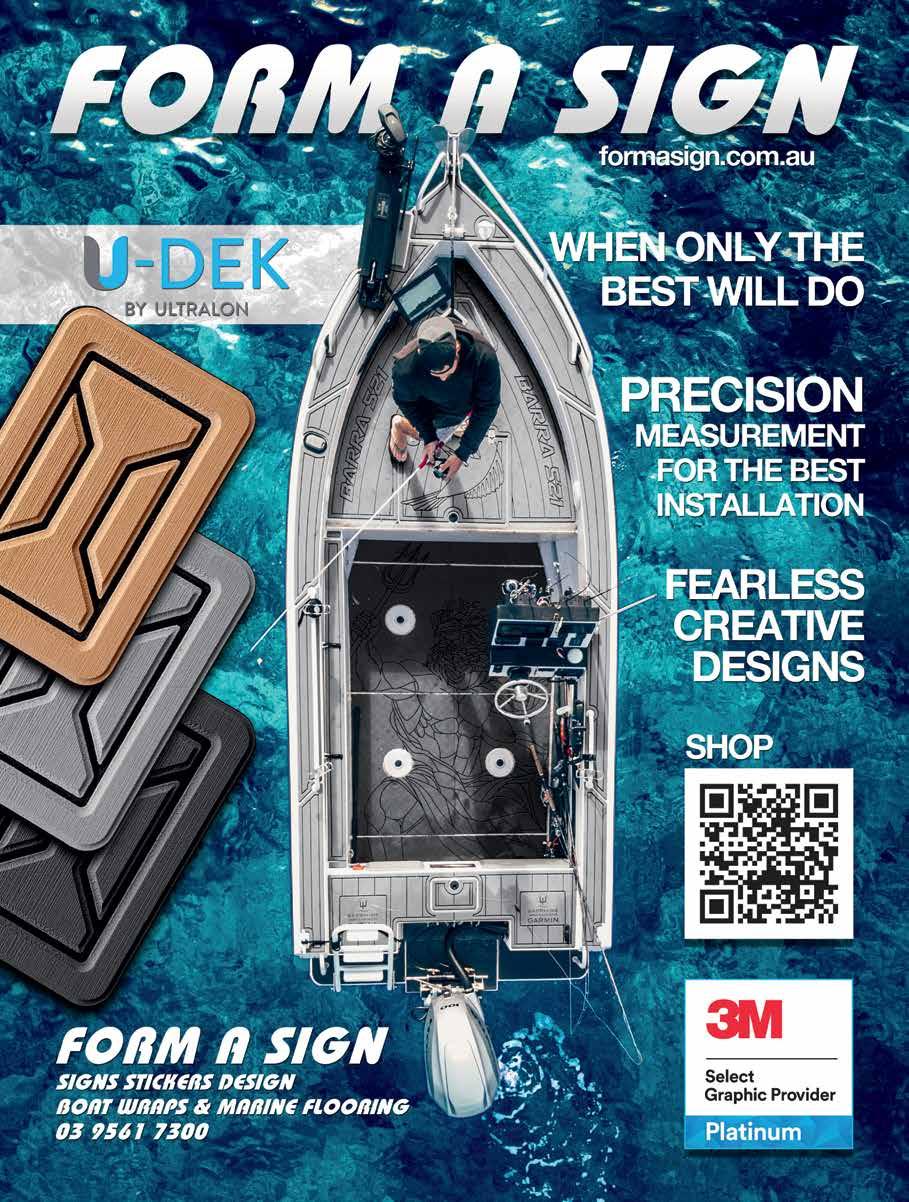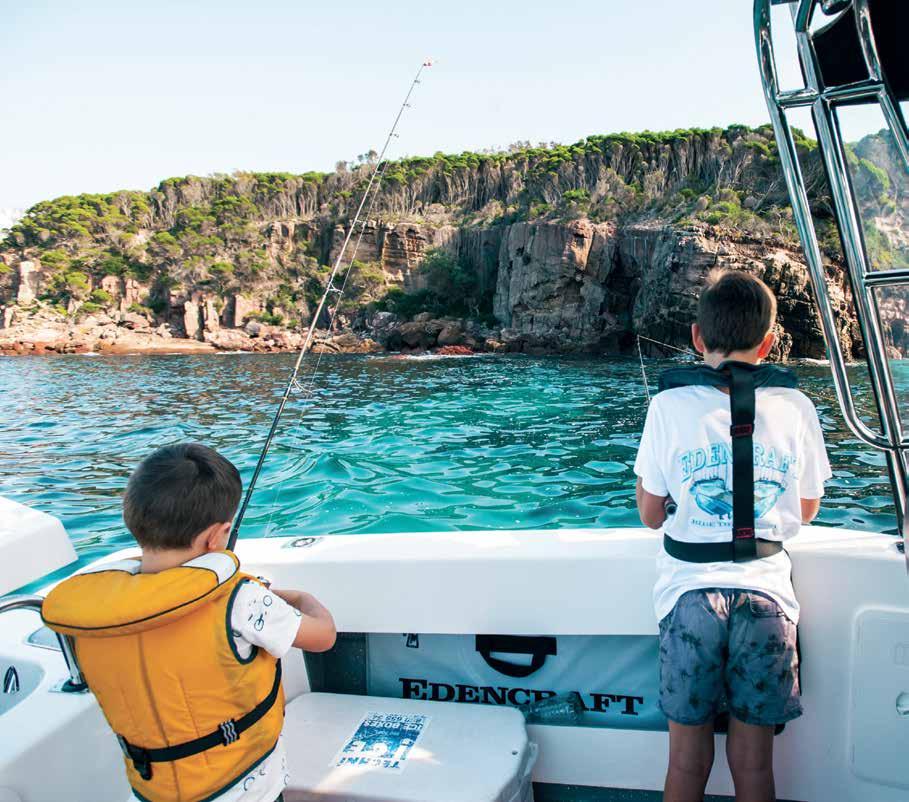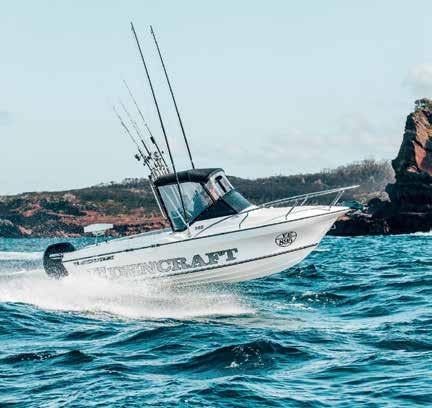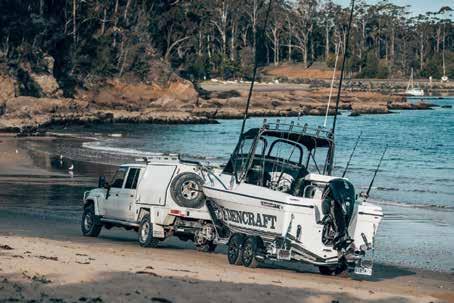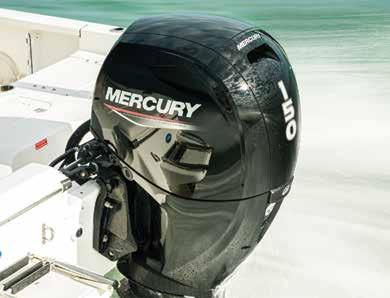
YELLOWFIN ON TOPWATER MULLOWAY IN RIVERS
TARGETING SCHOOL SHARKS
TESTED & REVIEWED




YELLOWFIN ON TOPWATER MULLOWAY IN RIVERS
TARGETING SCHOOL SHARKS
TESTED & REVIEWED


HDS ® PRO sets a new standard for underwater visibility. Get the highest resolution live sonar with ActiveTarget 2 ® . And ultra high definition clarity in the MHz range with new Active Imaging™ HD .
Bow-to-stern boat control with the Ultimate Fishing System , and detailed C-MAP ® charting make HDS ® PRO the most powerful fishfinding tool available.

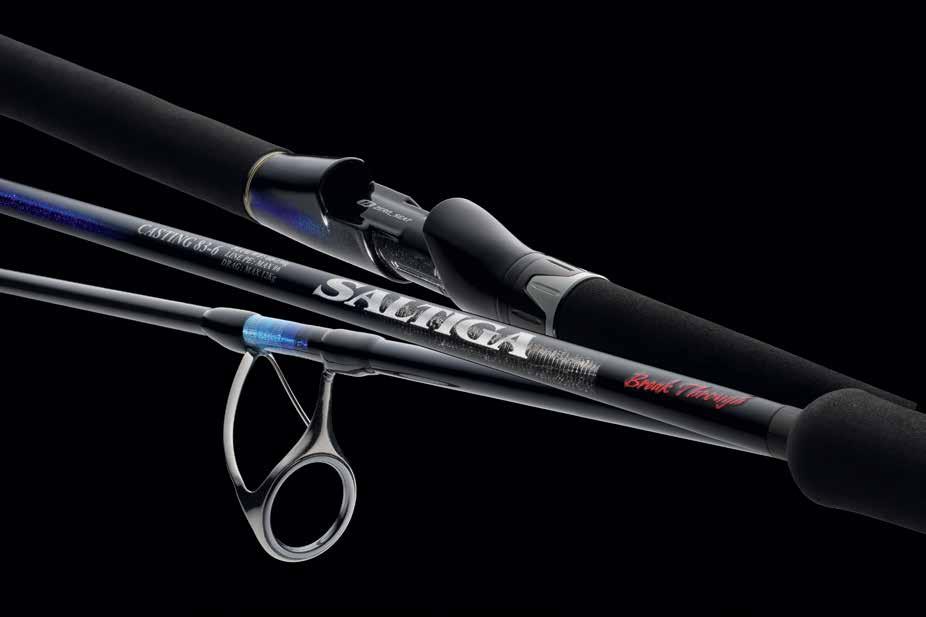




As we hit the festive season and summer comes into full swing, there’s no better time to be out on the water enjoying the incredible fishing opportunities that Australia has to offer. Christmas is here, and with it, the warmth of summer—perfect for long days on the coast, chasing everything from flathead and mulloway to marlin and Spanish mackerel. Whether you’re casting from a boat, a jet ski, or the beach, the summer months promise fantastic fishing, and we hope you’re able to make the most of it.
This time of year is also a great chance for us to reflect on what’s been an exciting and rewarding 12 months for Hooked Up magazine. We want to take a moment to thank our readers, advertisers, and contributors for all their support over the past year. Without your involvement, enthusiasm, and passion for fishing, this magazine wouldn’t be what it is today.
To our advertisers: your continued support allows us to bring top-quality content to anglers all over Australia, and we can’t thank you enough for partnering with us. To our writers and contributors: your epic stories, insights, and expertise keep our pages fresh and engaging—thank you for all your hard work and dedication.
Looking ahead, 2025 is shaping up to be a big year for Hooked Up. We’ve got some exciting plans in the works, with more gear reviews, destination guides, how to articles, and stories from Australia’s top anglers. We can’t wait to share more with you in the new year.
In the meantime, don’t forget to check out our website and YouTube channel for even more fishing content. From gear reviews to how-to videos and Rig Rundown our boating show.
And make sure to follow us on Instagram and Facebook for the latest updates, fishing reports, and community shoutouts—we love seeing your photos and hearing about your fishing adventures.
On behalf of the entire Hooked Up team, I’d like to wish you all a very Merry Christmas and a Happy New Year. Here’s to big catches, and great times with friends and family this summer. Thanks again for your ongoing readership, and we look forward to bringing you even more great content in 2025!
Kosta Linardos. Editor-in-Chief
CONTRIBUTORS
Sam Gilchrist, Jack Hammond, Jamie Crawford, Adam Hewson, Craig Pringle, Sammy Leys
ADVERTISING
info@hookedup.com.au





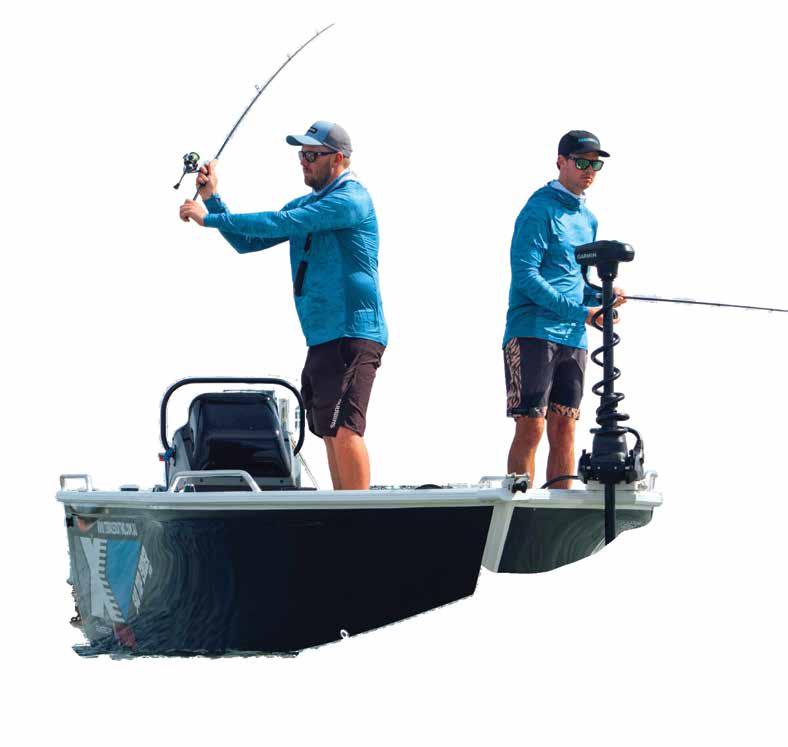

8 MED LIGHT / XX HEAVY SPIN | 5 LIGHT / X HEAVY BAITCAST MODELS
8 MED LIGHT / XX HEAVY SPIN | 5 LIGHT / X HEAVY BAITCAST MODELS
Shimano proudly reintroduces the iconic T-Curve rods, completely reengineered for 2024 with cutting-edge technology and design upgrades.
Shimano proudly reintroduces the iconic T-Curve rods, completely reengineered for 2024 with cutting-edge technology and design upgrades.
Featuring the advanced Armour 40-5 blank technology for unmatched strength and durability, the T-Curve rods are lighter yet more powerful, with enhanced force transmission and resilience.
Featuring the advanced Armour 40-5 blank technology for unmatched strength and durability, the T-Curve rods are lighter yet more powerful, with enhanced force transmission and resilience.
With Fuji KR Alconite guides, a refined Fuji reel seat, and ergonomic EVA and cork grips, each rod promises superior comfort and performance.
With Fuji KR Alconite guides, a refined Fuji reel seat, and ergonomic EVA and cork grips, each rod promises superior comfort and performance.
Available in 13 versatile models for various fishing styles—from estuary light spins to inshore baitcast—the new T-Curve range is a must-have for anglers.
Available in 13 versatile models for various fishing styles—from estuary light spins to inshore baitcast—the new T-Curve range is a must-have for anglers.
PRICED FROM RRP $399.00 T-Curve combines Shimano’s latest innovations with a sleek black-and-blue design.
PRICED FROM RRP $399.00 T-Curve combines Shimano’s latest innovations with a sleek black-and-blue design.
Just when you think you’ve seen and experienced everything along comes Salta Lures. This newe brand and all new lure dives to an incredible 115ft (30-35 meters plus) unassisted. This allows you to reach those deep schools of tuna or wahoo that you always see on your sounder but you could never reach until now. The MagRunner lure incorporates the patented HookMag system. The Patented HookMag system keeps the front hook in the stinger position at any speed until a strike occurs. The hook is then released with direct swivel connection to the hook. The HookMag advantage of releasably retaining the belly hook in the highly effective stinger position increasing hook ups, also means no more hassle and tangles, no more belly hooks stuck over the back of the lure, and no more interference with the lure body. The lure features a wire through construction on an ultrasonic welded solid polycarbonate shell (Not ABS) for increased strength. It also offers two front tow points, the first tow point trolls with up to 30% less drag, up to 8.5-9 knots whilst the second tow point is an all speed 1 -14 knots ultra-deep tow. The lure also features three layers of clear coating over the finish and comes fitted with only the finest hardware including a Mustad 7732 10/0 stainless steel straight bend hook on the rear, and a stainless steel 13/0 jig hook on the belly plus Japanese 300lb Split Rings & U.S.A. 555lb test ball bearing swivels. The MagRunner is 34cm in total length including the bib and weighs 187grams. It is available in 6 amazing colours that anglers fishing in offshore environments will love.
jurofishing.com

The Calca 82 hard body lure was derived from “Lates Calcarifer”, the scientific name for the Australian Barramundi. The goal was to produce a mid-sized, broad body suspending jerk bait aimed squarely at this iconic Australian fish. The design and engineering process was meticulous to deliver a tight, fast swimming action on heavy leaders commonly used when chasing these powerful predators. Produced from a high-density ABS with full through wire construction ensures strength and durability in the harshest environments. An integrated internal weight transfer system enhances castability whilst maintaining the perfect balance when paused ready for the bite! Dressed with premium YS-81 Japanese Decoy heavy duty hooks and split rings, this lure comes ready to do battle straight from the box.
prolure.com.au
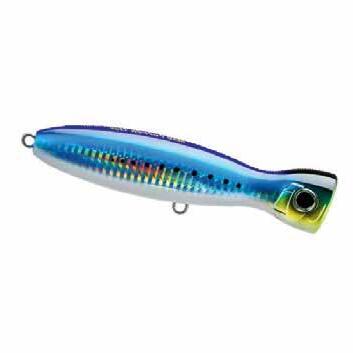

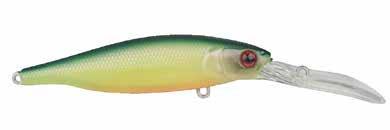
The Mag Popper features a gigantic water pushing face that fish find irresistible. This makes it perfect for stop & go retrieves, or a pause/jerk/pop technique, or a fast popping retrieve. The new Weight Transfer System makes for unbelievably long casts allowing you to reach bust ups and predators without spooking them. With a through wired body and 3X hooks and split rings the Mag Popper has been designed to withstand hard fighting fish under heavy drag pressures without failure.
tacspo.com.au
The Molix Glide Bait 140 is a versatile and high-performing swimbait designed to attract even the most hesitant fish. At 140mm (5.5”) and weighing 63g (2.1/4oz), this slow-sinking lure delivers a natural “S” shape swimming action when retrieved slowly, mimicking the movement of an injured baitfish. When jerked, the Glide Bait’s action becomes erratic, making it even more enticing to finicky predators. Perfect for targeting fish that are difficult to lure, the Glide Bait features robust treble hooks mounted on swivels, ensuring it holds up during intense battles. The 3D eyes and soft, realistic fins enhance its lifelike appearance, making it an irresistible choice for anglers chasing big catches. ejtodd.com.au
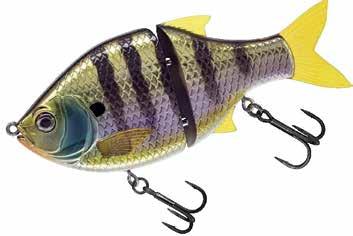
The Infeet Monster Crank 42DR was developed specifically for the Australian market. Designed to target estuary species like bream, flathead and estuary perch. Additionally, this versatile bait can also be used to pursue native freshwater species such as Australian bass and yellowbelly. Built with a long thin profile bib this lure can effectively dive to depths of 10-11 feet. Its swimming action is the perfect mix between a wide wobble and tight shimmy, making it excel with a slow roll retrieve or stop/start. The long lip will help it crawl over cover and deflect; this is when you’ll draw the strike. The Infeet Monster Crank 42DR is 42mm in length, 6.8grams in weight and available in eight colours. Combining the best elements of the Rollin’ Crank and Spike EXDR models, the new Infeet Monster Crank 42DR is a fish catching machine. daiwafishing.com.au

Reins is a Japanese manufacturer of high-quality soft plastics that are meticulously designed to catch fish. They are now being distributed into Australia by Gladiator Tackle who are well known for bringing in some of the most prestigious Japanese brands. One of the first models to hit our shores is the Reins S-Cape 3.5”. This paddle tail is a must-have for any serious angler chasing bass, bream, estuary perch, trout, redfin and mangrove jack. With its innovative design, exceptional action and 3.5inch size, it is perfect at imitating baitfish that reside in Australian rivers and estuary systems. Crafted from Reins’ high-quality soft plastic, the S-Cape features a ribbed body, shad profile and a dual colour pour that offers contrast and a range of colours that fish love. Its shape creates an enticing, realistic swimming motion and its natural vibrating tail action is active even at slow speeds and with light jig heads or when rigged weightless.
gladiatortackle.com.au
shad





Known for their innovation and renowned for their quality, Black Magic Tackle are releasing a new kona faced lure in December 2024. Jonah’s Kona XT, has been designed, developed and tested over the last 12 months, in conjunction with pro angler Jonah Yick. This new kona faced lure, has a scooped face and a reverse tapered head, which combines to create an aggressive swimming action. The head causes the lure to dig in hard under the surface and creates an erratic wiggle, which results in a heavy smoke trail. Jonah’s Kona sits with Black Magic’s XT lure range, with the head being made from XtraTuff material, meaning it won’t crack or break. Jonah’s Kona XT can be run in any lure position, but if you’re trolling in rough conditions it will excel in long rigger and shot gun. Available in 2 sizes - 8” and 6” - and in a range of colours, making them ideal for all sizes and species of tuna.
blackmagictackle.com
The Samaki Saltan Spinning Reel captivates with its carbon, silver, and metallic navy-blue aesthetics. Engineered with a carbon fiber rotor, a full metal body, and unique carbon handle, it strikes the perfect blend of strength and lightweight performance. The sealed drag system guarantees smooth, reliable operation. Available in sizes 4000, 5000, 6000, and 8000, the Saltan is ready for any saltwater challenge you face.
samaki.com.au

The Gan Craft Shift 113 is a premium swimbait and smaller version of the very popular Shift 183. At 113mm in length, the Shift 113 offers the perfect balance of size and action, making it an excellent choice for targeting a variety of predatory species, including bass, barramundi, flathead and other freshwater and saltwater targets. What sets the Gan Craft Shift 113 apart is its unique internal weight system, which ensures a smooth and stable swimming motion at a range of retrieve speeds. The lure’s design features a realistic body profile and finely crafted details, making it appear just like a struggling baitfish in distress. The Shift 113 is engineered for long-distance casting, with a built-in weight system that enhances both stability in the water and distance on the cast.
gladiatortackle.com.au
The new LOX Yoshi Series IV is here and features an all new blank crafted from high-modulus 30T + 46T Japanese Toray carbon. It features a 46T butt section and advanced IV Core Loop technology. This cutting-edge design delivers precision and specialised technical performance, making it an exceptional choice for discerning anglers. Incorporating the latest advancements in rod blank design, LOX achieves outstanding performance. The IV Core Loop enhances stability and minimizes distortion across the blank’s loading zone, resulting in increas faster recovery compared to traditional blanks. Additionally, the 30T + 46T Toray carbon is not only lightweight and durable but also offers superior vibration damping. This allows the rod to quickly stabilize after being shaken-whether by wind or movement-enabling be subtle fish signals.
vivafishing.com.au

Made from 100% recycled polyester jersey, this long-sleeve shirt is designed to keep you cool, comfortable, and protected. With raglan seams and side panels, the Tentacles sunshirt offers plenty of freedom to move, making it perfect for active days on the water. The three-piece hood with snap button closure provides extra sun protection, while the thumb holes keep your sleeves in place, so you’re always ready for action. Flatlocked seams add to the comfort, preventing any irritation or chafing during long hours of fishing. But this shirt isn’t just about performance – it’s got serious style too. Featuring a bold graphic of an octopus, printed on the front and back. Built for the serious fisherman (or anyone who just loves being outdoors), the Tentacles shirt offers UPF 50+ sun protection to shield you from harmful rays, while its sweat-wicking and anti-microbial properties keep you feeling fresh, even on the hottest days. Available in sizes S through XXXL.
saltycrew.com.au

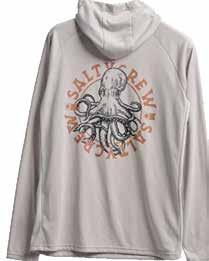
Meridian Tackle is a family owned and run business that has been around since the mid 1990’s. Meridian lures are now manufactured in Tasmania and are all hand made and polished, with unique custom handmade skirts with an original and unique style including the “Lumo” range. The lures are now being manufactured and continued to be developed by Danni and his family. All Meridian designs have had thorough field testing prior to their release, so you can be assured that your Meridian lures perform just the way they are intended. The Spectre Series offers a unique range of six sizes, designed with an innovative offset 10-degree cup face and an offset tow point. This distinct design makes it highly effective for attracting billfish and large tuna, which find it hard to resist. The lure is best suited for long corner, long rigger, and shotgun positions, and it runs most effectively at speeds between 5 to 9 knots.
meridiantackle.com.au
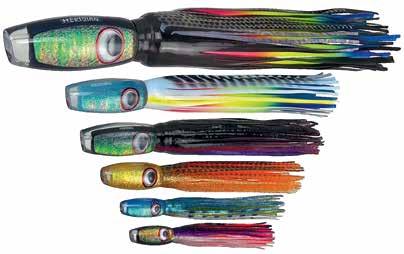
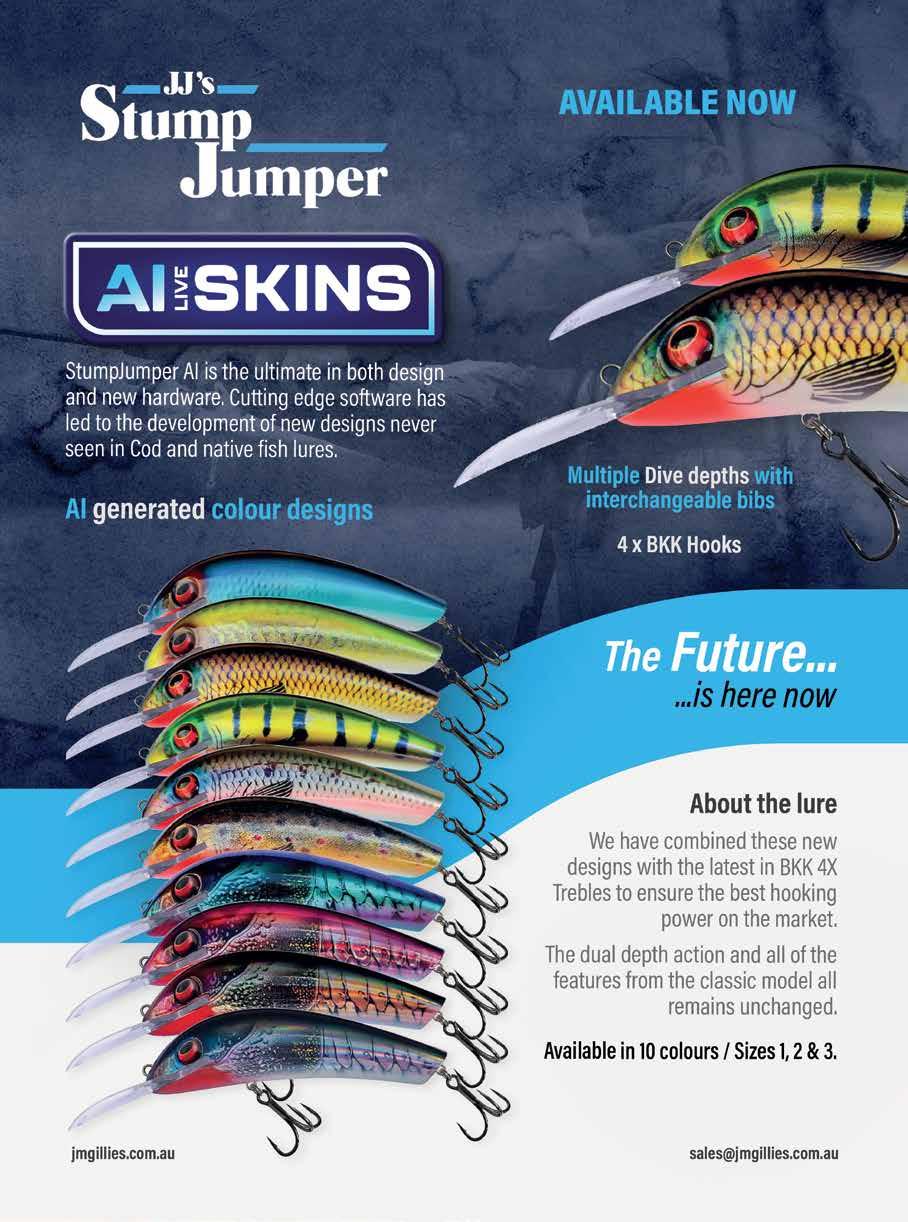



Shimano Ocea Easy Pebble jigs feature the amazing Scaleboost technology that give them complex reflections in the water like the scales of a real baitfish to fool wary, sharp eyed predators. Available in four sizes and five different colour patterns to suit Australian species. shimanofish.com.au
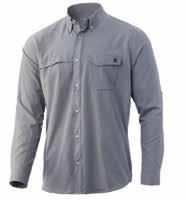
The Huk Tide Point is a performance packed, button-down, completely reinvented fishing shirt. The Tide Point shirt is designed to easily transition from the boa to the boardroom. With all-day comfort for both on and off the water the Tide Point is constructed using lightweight, breathable, quick drying, moisture wicking fabric with two-way stretch and built in microfiber sunglass wipe. Featuring Huk’s laser perforated underarms and back for supreme breathability, the fit and function of the Tide Point will quickly earn your respect. Stay cool, stylish and protected from the sun this summer.
jmgillies.com.au
Just in time for the summer pelagic season Maria have released four new colours in the Rapido range of stickbaits. Two transparent and two high-visibility shades—the Rapido range is now better equipped than ever to handle a wide variety of water conditions and lighting scenarios. The Rapido is available in four sizes: the 130mm (30g), 160mm (50g), 190mm (65g), and 230mm (100g). The 130mm and 160mm models come rigged with Owner ST-66 hooks, while the 190mm and 230mm are unrigged, giving you the flexibility to customise the rigging to suit your needs. The slim profile, tail-down posture, and enticing diving action make the Rapido a deadly choice for attracting species like kingfish, tuna, and bonito. Its range of sizes ensures you can match the baitfish profile to your target species. Many anglers love using the 130mm and 160mm sizes for targeting smaller pelagics like school tuna, bonito, salmon, and kingfish, while the larger 190mm and 230mm models are perfect for catching bigger fish, such as large tuna and trophy-sized kingfish. Made in Japan with a wire-through-body construction, the Rapido is built for durability and reliable performance. Whether you’re fishing in bright, clear waters or low-light conditions, the RAPIDO’s new colour options and proven action will help you land your next big catch. ejtodd.com.au




The Sasame 210A is a high-quality, Japanese-made stainless steel rolling swivel designed for serious anglers who demand reliability and performance. Made from premium stainless steel, this swivel is incredibly strong yet lightweight, offering outstanding smoothness and strength for its size. Whether you’re bait fishing inshore or working a big popper offshore, the Sasame 210A ensures minimal line twist, allowing your bait or lure to move naturally in the water for better presentations. Built to last, the Sasame 210A is a versatile, heavy-duty swivel that can handle everything from light tackle to the rigours of chasing big fish. It’s available in sizes 10 through to 5/0, making it the ideal choice for a wide range of fishing applications. Whether you’re targeting smaller species or going after larger game fish, this swivel won’t let you down, even under the toughest conditions. Don’t risk losing fish to poor quality terminal tackle. With Sasame, you’re getting a product that stands up to the demands of both freshwater and saltwater fishing. From the very first cast to the final fight, the Sasame 210A keeps your rig secure and your focus on the catch.
vivafishing.com.au
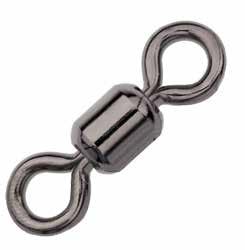
A new player has entered the surf and beach game with the arrival of the new Dragger rod line-up from Daiwa Australia. With the definition of the “Dragger” name meaning to ‘pull strongly’ the Dragger packs a punch and is designed for ultimate pulling power. Three ranges (X, SX, and Break Through) make up the series, each hitting a different price point, and all built for the needs and wants of Aussie anglers. Daiwa’s long list of proven rod technologies feature in the range. The Dragger Break Through and SX ranges feature HVF Nanoplus blanks, including X45X Full Shield on the Break Through, and X45 on SX, while the entry range in the line-up, Dragger X, features Daiwa’s robust and refined Braiding X blanks. V-Joint Alpha, V-Joint, Daiwa reel seats and Fuji guides featuring in the varying ranges and combined to deliver outstanding performance, strength, and value. The Dragger Break Through range features five models, Dragger SX five models, and Dragger X six models. From mediumlight models suited to light surf species through to extra heavy models tailor made for muscling giants off the rocks the Dragger line-up is primed to rule the waves.
daiwafishing.com.au

This high-quality gaff is expertly designed for anglers targeting large yellowfin and bluefin tuna, offering the strength and reliability needed to land these powerful fish. Constructed from structural-grade aluminium, both the handle and fitting are fully anodised to provide maximum corrosion resistance, ensuring long-lasting performance even in the harshest marine environments. The head measures 16 x 150, delivering the perfect balance of strength and precision for securing your catch with confidence. Lightweight yet sturdy, the gaff weighs just 0.9kg (900g), making it easy to handle while still being tough enough for big game fish. With a handle length of 1710mm (171cm), it provides excellent reach and control, giving you the leverage needed for safe and effective gaffing. Designed to float, it ensures easy retrieval should it slip into the water. Whether you’re chasing yellowfin, bluefin or sharks this gaff is built to meet the demands of serious game anglers targeting trophy-sized fish
gaffmann.com.au


The Yo-Zuri Rattl’n Vibe is a lipless vibrating style of lure that has a distinct rattle. The weight and BBs inside the Rattl’n Vibe increase the distance the sound travels under the water, while adding casting weight and emitting a natural shad-in-distress sound. This style of lure is well known in the freshwater fisheries and can be fished with different retrieves; fast, slow, stop-and-go, vertical jigged or ripping and falling action. Its perfect balance creates a downward swimming action on the fall at a sink rate of 30 centimetres per second. Available in six proven fish catching colours for the Australian market and made from a tough and durable ABS resin material to complement any anglers tackle box.
tacspo.com.au
Vexed has now developed the Micro Meat Hybrid as a micro version of the Bottom Meat for smaller fish species from boat or shore. This hybrid jig has been designed with whiting in mind to either use on its own, or on the bottom of a paternoster rig as a Fish Catching Sinker. Micro Meat is available in a large range of weights from 3.5gm – 130gm, and 10 colours, and designed to be used with small strips of fish or squid as bait for species including whiting, bream, flathead and inshore snapper. vexed.com.au



The traditional Bucktail and Marabou Jig may not look very technical or blingy, but for many species this lure option will simply out fish everything else. Old School Buck Tail Jigs have been the go-to lure choice for chasing a number of species over the years, but unless you want a filthy cheap option with a less than par hook, then you have to tie your own. Not anymore! Vexed has carefully selected a special blend of durable luminescent and UV fibres with a touch of flash and even a lashing of rubber in some options. These are all tied on Vexed Buckabou Jig Heads which are built using a strong chemically sharpened cutting point hook. Buckabou Jigs come in a range of sizes from 2.5gm to 28gm and are ideal for a range of species including flathead, bream, salmon, trevally, queenfish, herring, mackerel and deep-sea racing mullet.
vexed.com.au

The Sasame Stainless Steel Rolling Snap Swivel is the perfect tool for anglers who demand both convenience and reliability in their tackle. Made from high-quality stainless steel, this Japanese made snap swivel is built to withstand the toughest conditions. The smooth rolling action helps reduce line twist, ensuring your setup runs perfectly whether you’re targeting fresh or saltwater species. Available in sizes 8 through to 5/0, these swivels are designed to handle varying levels of drag pressure. The size 8 is rated for 17kg, while the larger size 5/0 can withstand up to 40kg of drag pressure, making it perfect for game fishing. Whether you’re trolling skirted lures for marlin or chasing other big game fish, the Sasame snap swivel ensures you can put the hurt on without worrying about failure.
vivafishing.com.au

Strike Pro in conjunction with the team at Juro Ozpro Tackle have spent 2 years developing this brilliant new lure. The Astro Shrimp is a realistic and unique Shrimp/Prawn imitation vibe for finesse fishing. The Astro Shrimp incorporates a Polycarbonate Belly with small in-built rattles and features assist hooks, so the lure is less prone to snagging the Assists also feature UV activated cord and UV feelers. This also allows for a transparent finish to be achieved in a metal blade and the belly section is UV for added attraction. The Astro Vibe Shrimp is 4cm long, weighs 10grams and is available in 9 magnificent colours. They are effective on Bream, Bass, Estuary Perch, Yellowbelly, Mulloway, Flathead and Redfin. These lures are certainly going to do some damage this year.
jurofishing.com
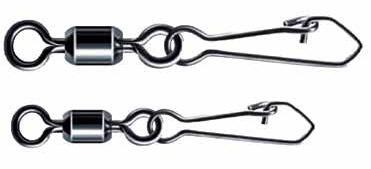
Introducing the Huk Rogue Wave Boots – a fusion of cutting-edge technology and rugged durability for anglers who demand the best. These boots are your go-to solution for conquering any fishing environment. The Rogue Wave Boots are built to defy the elements with weather-resistant technology, ensuring you stay dry and comfortable in any condition. Their rugged construction offers unmatched durability, providing superior grip on various surfaces with non-marking soles while providing protection against the toughest terrains. Designed for extended wear, these boots prioritize comfort with a cushioned insole and an ergonomic design, keeping your feet content during long fishing sessions. The quick-drying materials ensure you stay light on your feet, ready for every cast. Crafted with premium materials and a versatile style, the Huk Rogue Wave Boots seamlessly transition from boat to shore, offering both performance and aesthetics. Elevate your fishing experience with gear that meets the high standards of professional anglers – the Huk Rogue Wave Boots. jmgilies.com.au






























































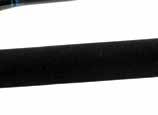


















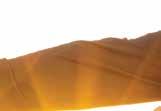

















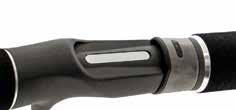

















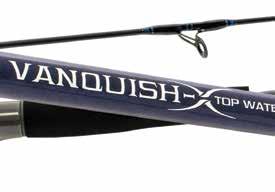













Finding the right pants has always been a struggle for anglers. It’s cold in the morning, warm in the afternoon and nothing in your wardrobe gets the job done. Denim is uncomfortable and track pants are no good if they get wet. Salty Crew has found the solution with their Midway Tech Pant. Available in three colours (Earth, Black and Charcoal) they are a straight fit pant featuring durable 2-way stretch performance fabric. Teflon EcoElite is a water and stain repellent coating that will keep you dry, cool, protected from the sun and allow you to move around the boat or shore with ease while looking stylish. A lasso waistband with custom drawcord, zip fly with snap closure and zipper security pocket at front right will keep you and your gear in good order so you can concentrate on catching fish in comfort. saltycrew.com.au
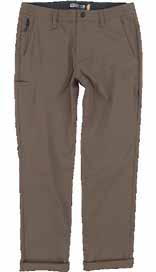
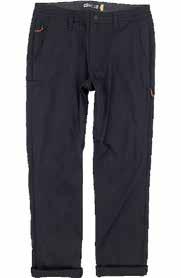
The Rainmaker 8in offers a cup faced front with 4 jet holes in the head to help create an amazing bubble trail as this lure trolls through the water. These lures can be used in most sea conditions and positions behind the boat. They come with many different head colours matching the skirts with some glow heads, some tinted and some offering Kauri shell. These lures come with most of the range offering a UV over skirt whilst the underskirt offers McLures exclusive “Luminite” (which glows in the dark on all colours). They also come with Red Crystal 3D Eyes and the resin heads are near indestructible. The Rainmaker is 9.5in overall length with an 8in skirt and weighs 120grams. These lures are available in 13 brilliant colours that will appease any anglers targeting marlin, yellowfin tuna or southern bluefin tuna barrels. jurofishing.com

The Huk Pursuit Vented Hoodie is packed with Huk Performance Technology to handle the elements on the water. This lightweight crew neck shirt with mesh vented sides is an ideal layer on cooler days and perfectly worn by itself when it’s hot. With +UPF 50 to block UVA and UVB rays for all-day sun protection, stain-resistant, anti-microbial treatments, and superior breathability: the Pursuit shirt is a must-have for any anglers arsenal. jmgillies.com.au


Samaki is proud to announce the release of the Zephyr CNC Jigging Reel in 2024, a testament to our commitment to quality and innovation. Boasting a Cold Forged CNC Body and Machined Brass Gears, this reel is unmatched in strength and durability. The Zephyr Jig features luxurious matte black cosmetics with brushed gold details, exuding sophistication and style. Available in two sizes—1500 and 2000—the 1500 is perfect for inshore slow jigging for species like snapper, pearl perch, and coral trout, while the 2000 is ideal for offshore deepwater jigging for species like Tuna and Kingfish. Both models feature an ergonomic Power Handle, ensuring comfort during even the most gruelling jigging sessions. Equipped with a carbon drag system and a 6:2:1 drag ratio, the Zephyr CNC Jigging Reel offers the perfect balance of speed and torque for specialized jigging applications.
samaki.com.au
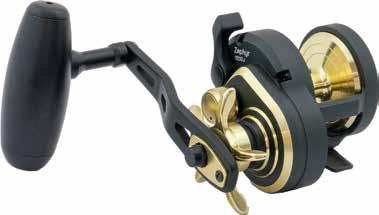
Shimano Ocea Wing Fall jigs are a slow fall style jig available in three sizes and five different colours to suit Australian condition and feature Scaleboost technology that give them complex reflections in the water like the scales of a real baitfish.
shimanofish.com.au

The Zing Baitcaster Reel features a lightweight Carbon Frame, 6+1 Stainless Steel Ball Bearings, Magnetic Cast Control, and a Smooth Carbon Fiber Drag. Available in three sizes: Zing 80 for light game setups with 4kg of drag, Zing 100 as an all-rounder with 6kg of drag, and Zing 200 for larger species like Murray cod and barra with 8kg of drag. The sleek gunmetal finish with striking red details ensures both style and performance.
samaki.com.au


The Sasame 210E Rolling 3-Way Swivel is a versatile and reliable piece of tackle designed to simplify your fishing setup. With its innovative 3-way design, this swivel allows you to easily connect multiple lines or components, making it perfect for a wide range of fishing rigs and applications. The Sasame 210E offers the flexibility you need to keep your setup running smoothly when bottom fishing. Crafted from high-quality materials, the Sasame 210E is built to last, providing exceptional durability and performance. It is resistant to corrosion, making it equally suited to both freshwater and saltwater environments. The swivel’s smooth rotation ensures tangle-free operation, effectively preventing line twists and knots that can cause frustration during your fishing sessions.
vivafishing.com.au
The Saltiga family welcomes a new series of premium casting rods with the release of the Saltiga Breakthrough range. The range features three models (C71-10, C82-8, C83-6) each designed for ultimate strength and casting performance. The foundation of the Saltiga Breakthrough is its blank with Daiwa’s ultra-light performance focused SVF Compile X Nanoplus carbon blank combining with X45X Full Shield for supreme strength, sensitivity, and power. V-Joint Alpha further enhances blank performance, with its bias construction eliminating joint flat spots and weakness at the joint in multi-piece rods. The Saltiga Breakthrough’s componentry is equally performance and designed focused with Daiwa’ new Zero Seat providing ultimate comfort, palm-ablity and strength, while Fuji Titanium framed SiC guides deliver heighted sensitivity, strength, and control. Featuring Fuji LRV guides on the lower section and Fuji K frame guides on the upper section the Saltiga Breakthrough guide train is built to handle the harshness of the Australian saltwater offshore scene. If you’re looking for supreme casting strength and performance in the offshore realm look no further than the new Saltiga Breakthrough range.
daiwafishing.com.au

Mercury Marine has announced a software update for its SmartCraft operating system that gives Joystick Piloting powerful new capabilities. The system can now automatically counteract the effects of wind, waves and current while a boater is driving with the joystick, giving them the ability to dock and manoeuvre with effortless precision. For more than a decade, Mercury has evolved and grown the Joystick Piloting offering to allow precise 360-degree control and slow-speed manoeuvrability on all primary types of propulsion. The system makes it easier to perform complex manoeuvres, such as docking or navigating in confined spaces. The SmartCraft system can now detect if wind, waves or current cause the boat to drift off course during joystick manoeuvres. It will then immediately adjust throttle and steering to counteract the force so the driver doesn’t have to make additional corrections. This affords an unprecedented level of control and operational ease by helping to keep the boat on the driver’s desired course. For instance, during sideways and yaw manoeuvres, boaters can experience up to a 74% reduction in unwanted fore-aft drifting. The software now utilizes vessel speed-based joystick operation in place of the prior rpmbased system. Previously, when the driver moved the joystick, the engines would accelerate to an rpm level to match the amount of joystick input. If the boat encountered a force such as a headwind or tailwind, the resulting speed over ground would be impacted. Now, the joystick input translates to actual speed over ground. If the system detects a change, it automatically increases or decreases throttle to maintain the driver’s desired speed. The enhanced software will now be standard on new multi-engine Joystick Piloting installations from Mercury, Mercury Diesel, MerCruiser and Mercury Racing, with next gen Digital Throttle & Shift controls.
mercurymarine.com
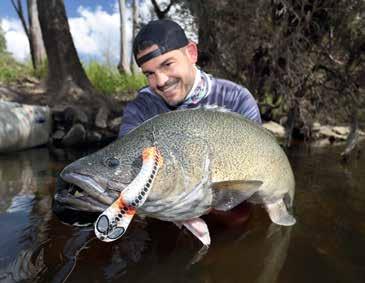
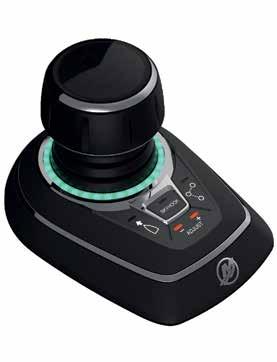
Some of Victoria’s most popular inland fishing spots will be drawcards for anglers now the annual Murray cod fishing season has opened. Cod opening is Christmas come early for many freshwater fishers and follows the annual three-month closed season – applicable to most waters north of the Great Dividing Range – which gives the iconic native species a chance to breed in peace. Victorian Fisheries Authority CEO Travis Dowling said while large impoundments such as Lake Eildon, Rocklands Reservoir and Lake Eppalock are now open year-round, summer presents terrific fishing opportunities in rivers, creeks and smaller lakes. Mr Dowling said Murray cod could be caught on relatively simple gear and were often found among woody habitat such as submerged logs and fallen trees. More information on bag and size limits can be found at the VFA website.
vfa.vic.gov.au/murraycod
Looking for a versatile and comfortable seating option? Look no further than Edencraft Bean Bags. Designed to handle the great outdoors and complement indoor spaces, these bean bags are a must-have for anyone who values comfort and durability. Made with weather-resistant materials, Edencraft Bean Bags thrive in outdoor environments, whether perched on your boat deck, by the pool, or nestled in your living room. They’re also an excellent seating option for kids aboard the boat, providing a safe and cozy spot on the deck. Measuring approximately 750L x 600W x 700H mm when filled, they’re compact enough to store in your boat cabin yet spacious enough to provide relaxation for lounging, reading, napping or waiting for the next bite. Order yours today online and experience the perfect combination of style and functionality!
edencraft.com.au
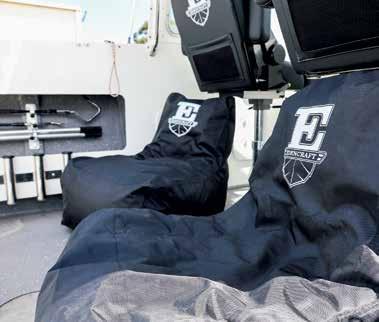



A special copolymer nylon blend manufacturing technique is used to produce impressive power and abrasion resistance. With TRP (triple resin processing) processing, it is superior in repelling water while still remaining very supple and easy to handle with excellent knot strength. Being supple this quality leader does not impair the movement of the jig or lure plus it absorbs the shock of sudden strikes and hook sets.
Made in Japan. Available in: 50m spools 4lb to 150lb

Siglon PE AMZ is an all-new braid and sets a new industry standard with its breakthrough Performance Sustainable Processing (PSP) across both its 4 strand and 8 strand braided lines. PSP is meticulously applied to each braided line strand. This ground-breaking technique serves as a game-changer, significantly extending the initial performance lifespan of the line while providing a slicker and smoother finish that lasts.
Made in Japan. Available in: Orange: 150m spools: PE 0.5 - PE 3
Multi Colour: 300m spools: PE 0.6 -PE 8
www.ejtodd.com.au
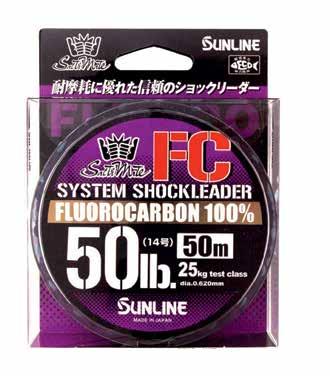
A 100% fluorocarbon leader that features high abrasion resistance and high sensitivity. The design allows for a perfect transfer of movement to your jig or lure to hook a fish. Even though it is fluorocarbon, it can withstand big shock becasue of its smooth and tenacious features. Knot strenght is excellent. Parallel spooling decreases line surface damage.
Made in Japan. Available in: 50m 12lb to 50lb. 30m 60lb & 100lb

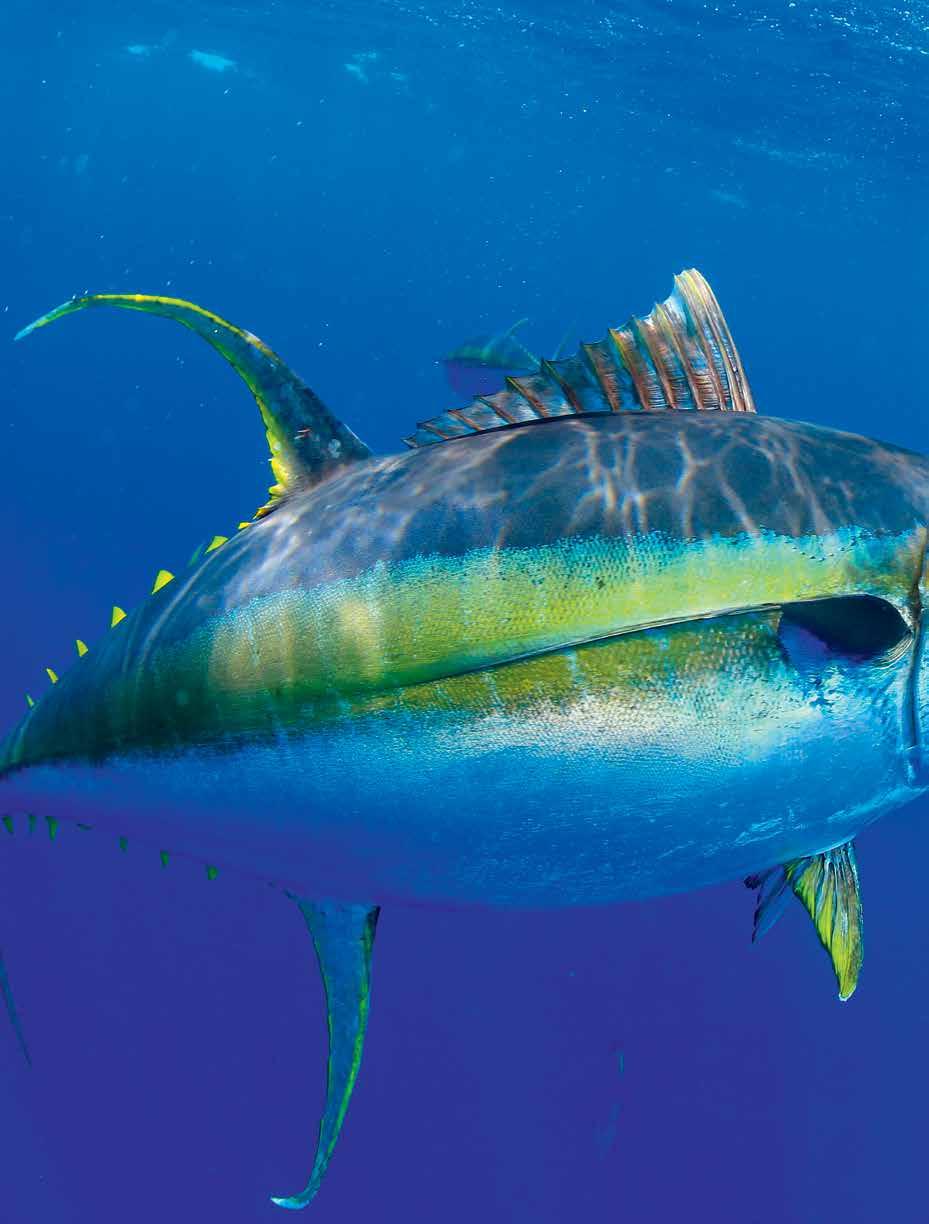

Yellowfin tuna are at the pinnacle of sports fishing, with NSW crews landing some epic specimens on topwater.
Words: Sam Gilchrist Images: A full crew
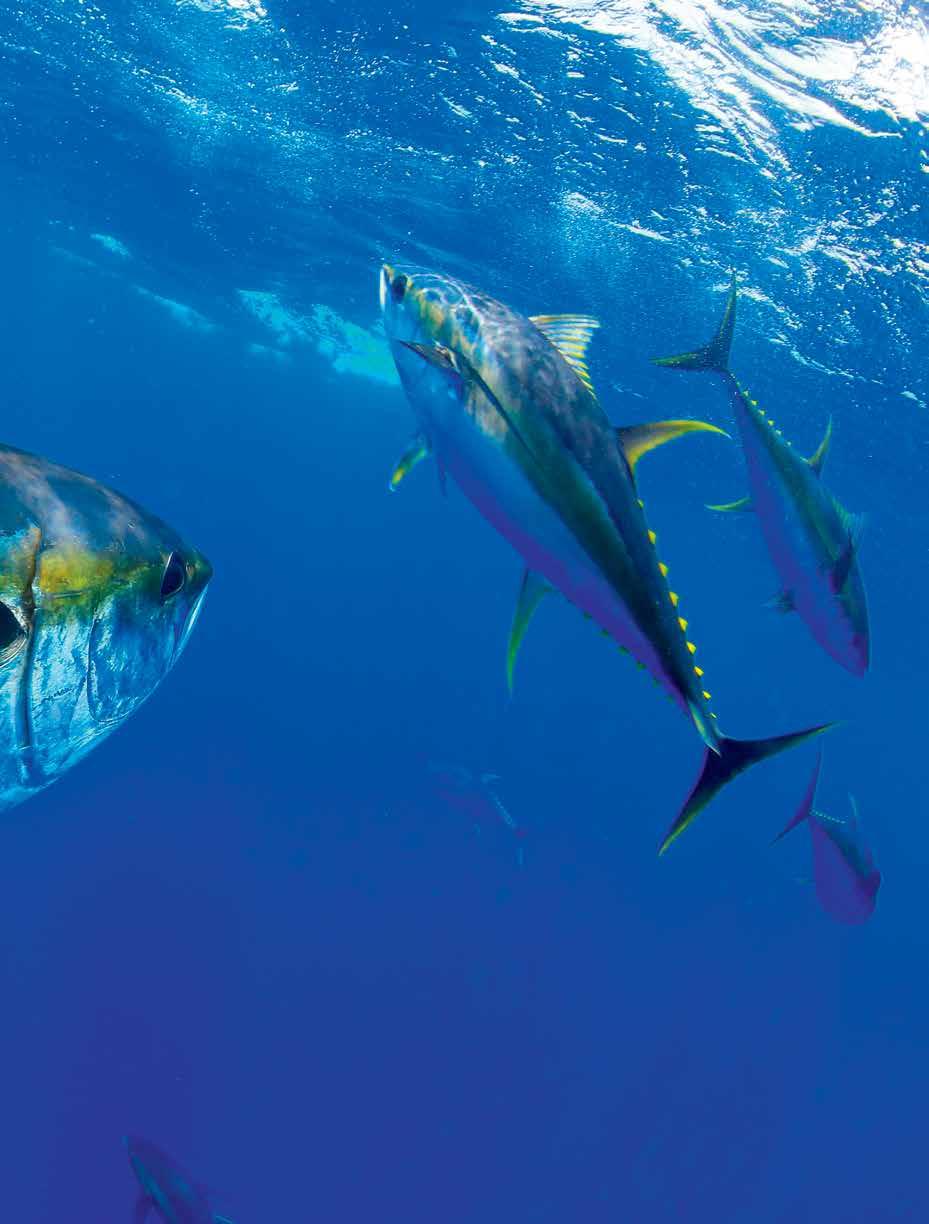

For generations the mighty yellowfin tuna has been revered by anglers as one of the pinnacles of saltwater sports fishing. In this article we introduce you to the new hardcore method of targeting this species by casting topwater lures at large schools of airborne fish that has changed the game forever.
A crew of topwater enthusiasts started targeting large tuna off the mid-NSW coast and changed how Australian anglers viewed this fishery. The first I saw of this relatively new target method was through Mike Bonnici of Sydney, who kicked off his topwater YFT addiction with some healthy 30-40kg specimens over the shelf off his home city. The size quickly escalated to 50kg and then 80kg fish and a true addiction was born.
Crews led by the likes of Sandy and Luke Gorecki, Jake Brisbane, Mick Fuller and Paul Wray began chasing these schools of epic fish up and down the NSW coast. All of a sudden, massive tuna with their distinctive
fins (resembling sickles) were being actively targeted and consistently caught by trailer boat anglers on topwater.
The truth is there is a lot of water in the ocean – and when you’re 22 to 50 miles east of land you can be easily overwhelmed by the sheer volume of nothing. There’s no replacement for time on the water and the insights and skills you’ll develop through fishing with better anglers and reading Hooked Up, but you can reduce 2,137km of NSW coastline to a 20 to 50km area in which to start your search. There are two apps used by recreational and professional anglers when chasing schools of yellowfin: RipCharts and TZ iBoat. They’re both paid subscriptions – which like everything in fishing cost your hard-earned – but are essential in my view and worth the investment. You could save hundreds of hours and thousands of dollars in fuel if you can decipher the YFT pattern.
While using these apps you’ll learn a few new sayings such as altimetry, chlorophyll, zero line, sea temps, upwelling and currents. You’ll need to understand these terms, their meaning and what the tuna like in order to effectively reduce that 2,000km of wasted travel to 20km. It’s no easy feat!
To get you started in the right direction, you can look for an upwelling, zero line and a temperature break just beyond the continental shelf. There’s a lot more to the water beyond the shelf than you may realise, and by learning to read the water (the same as reading the water up on the Barrier Reef, say), the more success you’ll have.
Your marine charts and sounder technology may not appear to be as important as it is during your shallow water applications, though once you’ve found your formula on or in a canyon on the shelf, your marine chart will become critically important again. When you sound a school of YFT at 80m below

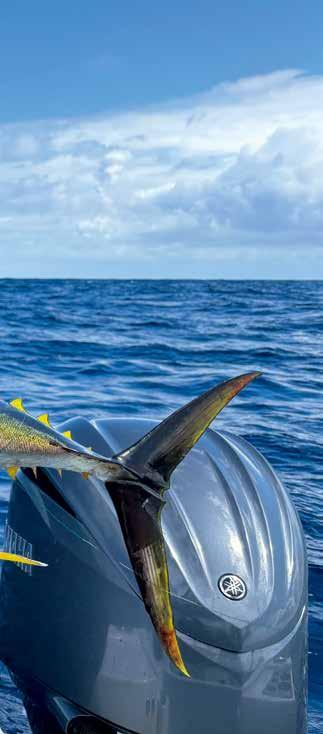
the boat and raise them up to your topwater lures, you’ll appreciate your sounder more than you did before.
All creatures of the sea must eat to survive and seabirds are no different – they are built to thrive in one of the harshest environments on the planet, our oceans. Three key birds to look for are muttonbirds, gannets and terns; each will be your guide to yellowfin on their day. Study their behaviour acutely and learn to read their behaviour intimately and I can guarantee your rate of success will increase substantially.
I often wonder what physical and sensory tools these birds have that gives them the advantage when chasing down food in the water. Do they have polarised eyes beyond our comprehension? How do they know well before anything or anyone else that a YFT feeding frenzy is imminent? The birds know
so much more than we do – they have to in order to survive and because their lives depend on it, you need to learn so much about them and trust me when I say, they will show you the way. Different bird species prefer different baits that the tuna feed on. Understanding this will get you a long way when understanding what birds to follow on any given day. Binoculars are a great tool to have on the boat when searching for birds.
Growing up as a young fella in the 80s I can still recall the game fishing fraternity using methods such as cubing and trolling for YFT to great effect, and the south coast crews around Bermagui made that area famous with long golden sickles.
Now, I’m not saying there isn’t a place for these tried and tested methods, though my impression is that most YFT captures, particularly since the decline in YFT biomass due to commercial catches, were by-catches while trolling for billfish.
My personal preference is to leave the trolling gear and outriggers at home. In fact, most of our success has come from chasing down schools of yellowfin and casting topwater lures at them – the bites are incredible, the fight exhilarating and the opportunity to catch several fish in a session is real. In this instance outriggers and other kit really does get in the way. You’re also far more mobile, as tuna move very quickly and when they’re blowing up 500m away, 8-12 knots feels very slow.
Though there’s a bit to it as casting on repeat and fighting large fish takes a physical toll,
the reward for effort is balanced. You must be able to cast a long way. Occasionally yellowfin are very sensitive to boats and you’ll need to be able to cast a long way to get to them. Occasionally they’ll blow up all around the boat and everyone will get bites regardless of the cast distance, but this is the exception, not the norm.
Varying your retrieve is very important: sweep, twitch, burn and skip. Each method will trigger bites from tuna, you’ll just need to understand what they want on the day. If you’re sounding tuna down deep, say 50m or deeper, don’t be afraid to throw a popper, as the commotion the popper makes can be very effective when raising fish sitting deep. YFT have very hard mouths and very hard faces, so make certain your hooks are sharp, strong and when you get the bite, absolutely wallop them to set those hooks and drive them home.
When it comes to lures, match the hatch. Take note of the bait they’re feeding on and try to find something that imitates it. What I consider when selecting a lure is how far I can cast it. If you can’t cast your lure a long way, don’t tie it on. Some stickbaits feel like you’re casting a balloon, you do not want that one when the fish are at the end of your cast range. What size bait are the tuna feeding on? How does the lure swim? A lure that swims on the sweep and also skips well on a fast retrieve are important factors, so talk to your local tackle store and get them to help you find some suitable stickbaits and poppers that feature these attributes.
You’ll note in some of my images I use the Chain Knot as a connection knot to my swivel at the nose of the lure. It never fails and it acts as a shock absorber, as if you lean into
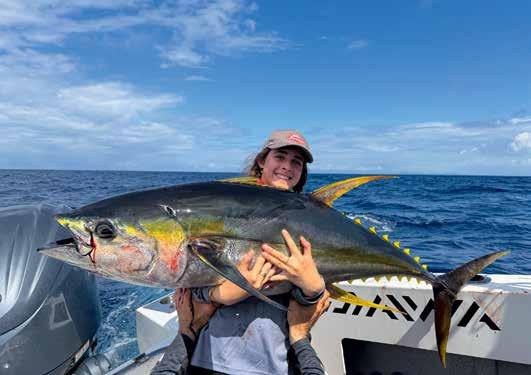
a Chain Knot it expands and flexes like a spring. For me it means you pull fewer hooks, particularly during a long fight.
When it comes to topwater casting rods I am sponsored by Daiwa and love using its gear because it’s been designed for a purpose. There are many rods on the market you can choose but I love using the Daiwa Saltiga Breakthrough in PE8 and PE6 and the Daiwa Spartan S85 PE 6/8. These rods enable me to cast big lures all day with distance and are designed to maximise the retrieves of topwater lures. The butt and handle configurations are also designed to make casting, retrieving and fighting big fish as easy and efficient as possible. Yes, this is high-end gear, but big game fish require quality gear. I pair these rods with either a Daiwa Saltiga or Certate SW 14000. If you’re chasing fish over 80kg I’d go up to an 18000 or a 20000. I spool my 14000-size reels with Daiwa Saltiga 12 braid in PE4 (68lb) or PE5 (88lb). While I’m using PE6 and PE8 rods, this high-quality 12-strand braid features an outstanding breaking strain for its diameter. With the thinner line I can cast further and work my lures with more control. I then connect a 150lb leader to my braid via an FG knot. I use Saltiga Nylon which provides shock absorption and abrasion resistance.
My leader is only around 180cm and on long casting rods this means the leader is never around the spool when casting, which greatly increases casting distance. Remember, these tuna can be boat-shy so casting distance is extremely important. The shorter leader is what allows me to have such a disparity between the diameter of the braid and the leader. If you try casting PE4 or 5 with a long 150lb leader you will have a lot of troubles with wind knots and the line could wrap around the stripper guide, so keep it short.
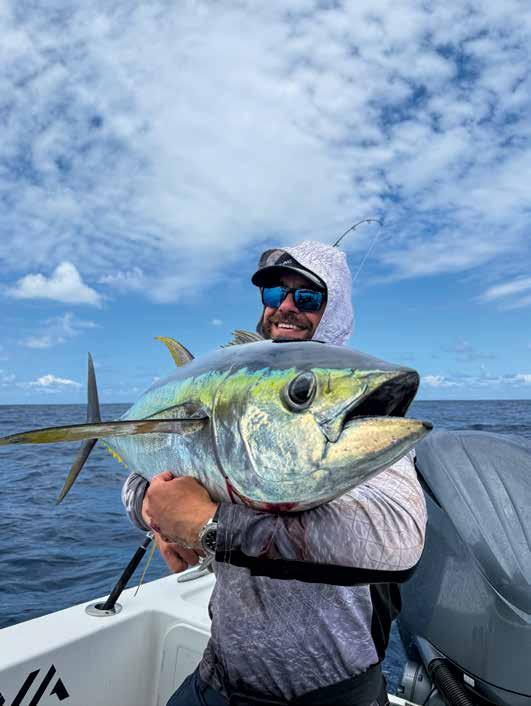
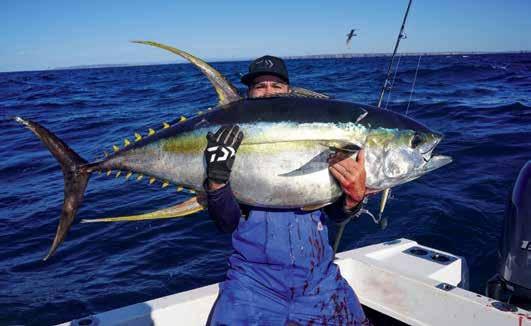
So you’ve found the tuna, you’re all geared up and perhaps you’ve overcome the shock and awe of seeing these beautiful fish (hopefully airborne). After you’ve buried the hook in one, you’re on. Now here’s what you can expect: topwater fights are often short-lived as the stickbait or popper seems to really upset the fish and really deregulates their ability to fight hard. Hook placement will have a direct impact on how your fish responds, though most of the time a YFT will struggle to pull much more than 100m of line against what is substantial drag on PE6 and PE8 gear and their ability to circle under your boat is reduced due to the use of braid, short leaders and some amazing equipment by way of rod and reel. Expect fight times of 5 to 45 minutes depending on the size of your fish, hook location and how hard you want to pull on them.
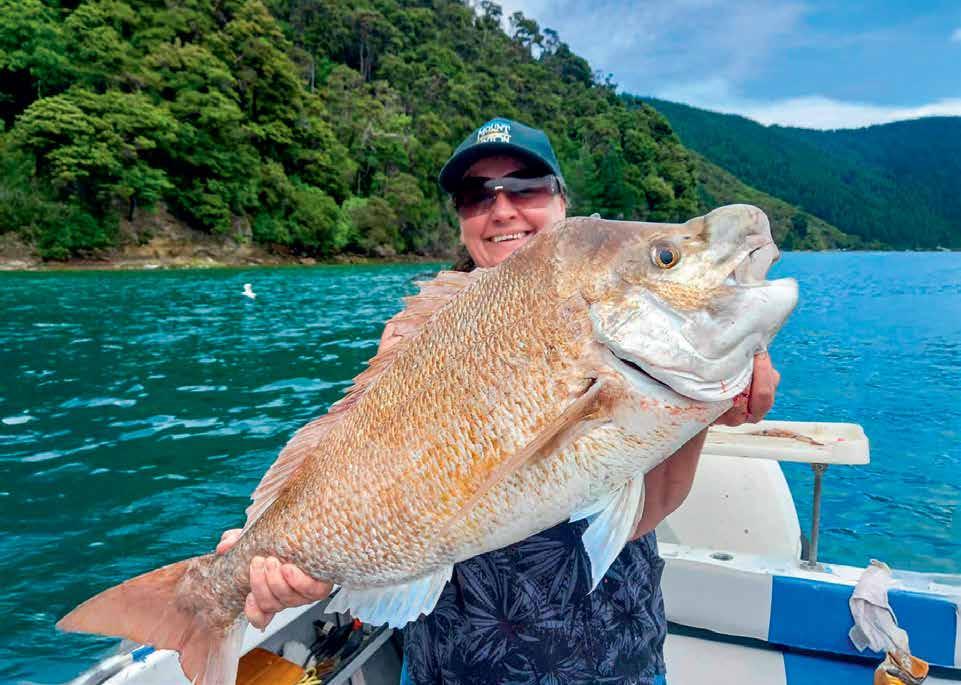



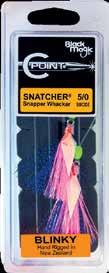
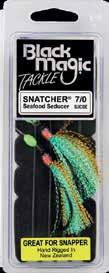

Have two gaffs on board, even three, if you’re going to take a fish for the table. Be patient with your gaff shot and never go deep to take your shot. These fish, especially when they’re above 50kg, are very powerful and will rip gaffs from hands, or bend and break them. Aim for the head to secure your shot, it’s a tough area and protects the prized meat from damage. You can also steer and lift the fish much easier from the front, then from the mid-section and most certainly the back end. Be prepared for the madness about a minute or two after landing your fish, as yellowfin that are not brain-spiked will go absolutely berserk in your boat and have the potential to cause injury and damage your boat, so get photos quickly then stow your tuna to prevent this.
Releasing YFT is a very dangerous activity, though with catch rates going through the roof and the high yield of YFT meat from each fish it is important you have a system to safely release your share of tuna. A large claw-like lip grip built by an Italian company called the Pratiko would be the most effective way of controlling a fish boatside for release, though this bit of kit will set you back $500.
You cannot really take these fish out of the water if you intend to release them. If they’re removed from the ocean, tuna will not survive, so it’s best practice to catch only what you intend to keep or spend the money and take care if you want to catch and release.
Long pliers are a minimum requirement; wrap the leader close to your lure and keep the boat idling forward to give the fish direction, then remove the hooks. If things go wrong here, I hate to imagine the outcome, so please take extreme care.
To make release safer, I’d recommended removing trebles and fishing a single on the


rear of your lure – you will have a reduced hook-up rate, but you eliminate a lot of risk when it comes to letting fish go by running your lures this way.
Brain spike, bleed, ice – it really is that simple. You’ll require an XL insulated fish bag and lots of ice if you intend to keep a few of these beautiful fish. Be warned, large YFT melt ice very quickly. The best practice is to empty the YFT gut cavity when icing your fish, which will chill the meat from the inside out. These are special fish and they’re in immense global demand for their eating qualities, so treat them carefully and you will maximise your culinary experience.





School sharks are found the world over and surprisingly underrated – so now’s the time to go for this hard-fighting table fish.
Words & Images: Jamie Crawford

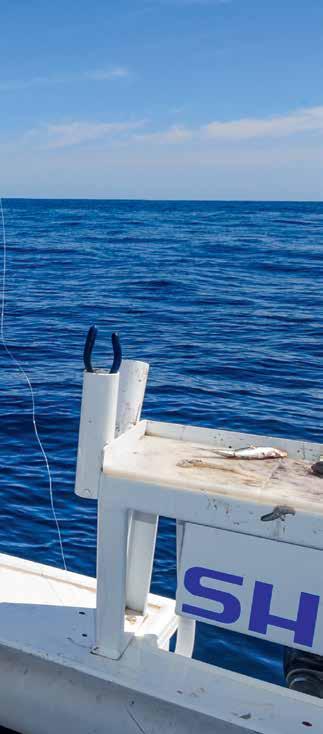
School sharks, or tope as they are globally known, are a species of shark distributed around Australia’s southern coastline. They are often overlooked and underrated as a recreational species, but they’re a worthy target in my opinion. On the right tackle, school sharks put up a great account of themselves, and on the table they offer quality fillets. If you don’t mind a feed of flake they’re definitely worth putting in the ice box, and I would rate them almost as good as gummy shark. They are also an important commercial target in our southern states.
As their name suggests they are a schooling species, so the action can come in thick and fast once a school is located. They are a demersal species of shark – meaning they predominantly move and feed close to the sea floor, but they will rise into the water column to chase food. Occasionally they will follow a
hooked fish to the water surface from as deep as 70 to 80m of water.
School sharks are quite similar in appearance and distribution to gummy sharks, but with a few slight variations. Schoolies lack the white dotted flanks found on gummies, their nose is quite pointed and almost translucent or opaque, and they have small teeth – which is the biggest give-away. Schoolies are a bit bigger on average and – in my opinion –fight harder.
School sharks have a global distribution and often migrate large distances each season. The species is found throughout South America, the southern tip of Africa, the west coast of the United States, the North Atlantic and around New Zealand. Here in Australia they are commonly encountered from Albany in the west, through South Australia and around Tasmania, and along the Victorian coastline to Southern NSW. They are occasionally found higher than these boundaries, but the southern coastline with its cooler temperatures is their preferred range.
School sharks have slender bodies, with the average shark being around 15 to 18kg, or 120-140cm long. Any schoolie over 20kg is a quality shark and anything pushing 30kg is a trophy fish. They often aggregate in schools of similar-sized sharks, which can make for exciting fishing. In my local area, we’ve been seeing school shark numbers increasing over several years, which has been great to see, and the commercial sector has noted the same trend.
School sharks have a wide environmental range and can be found along open surf beaches, over natural reef structure from around 15m deep, right out to the edge of the continental shelf. Unlike gummy sharks,
however, you don’t see many schoolies in our shallow bays as they predominantly hold over deeper structure. In my local area we see quite a few school sharks around our bluewater reefs from 30 to 60m of water during the day, and at night we find them pushing closer to shore.
This gives the option to target them around our bluewater reefs during the day, and along near-shore reefs after nightfall. We have a good network of limestone reefs that rise from around 50m of water and peak at about 35m, which are pretty consistent for these tasty sharks. We can catch school sharks yearround, but the peak months are from April through to around July for my local area, and this is when their numbers are at their best.
There are a couple of ways you can approach the fishing: either at anchor or fishing on the drift – and there are pros and cons for each style. Anchoring and deploying a berley trail is a super-effective way of targeting school sharks if you have the time to establish the trail and wait on anchor. It can be a reasonable wait before school sharks arrive on the scene, but once they arrive the action can be hectic. If you’re going to tackle school sharks in this manner, aim to drop anchor to the side of a reef system so your baits are settling on the flat sea floor next to the reef, but not in the hard structure. If you anchor right on top, your baits will get hammered by the assortment of reef species that call this area home.
Try sounding around the area first and try to position the boat so the berley is flowing towards the reef. In the berley pot I like using oily fish such as chopped pilchards together with some tuna oil. You’ll need a good weight
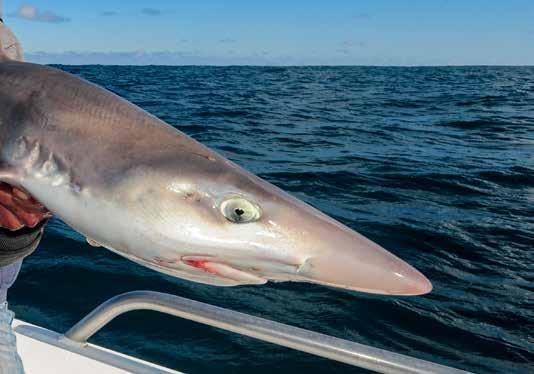
in the pot to ensure it drops straight down and doesn’t flail out the back of the boat.
Bear in mind this is quite deep water to be dropping your anchor and dropping a berley pot. If the water is 50m deep, you’ll need more than 100m of anchor rope out. It is an effective way of targeting these sharks, though, and with the aid of your berley you’ll often hold the school in the area for some time.
Once the berley pot has been dropped, it’s time to drop a bait to the bottom. I use a running sinker clip so I can change the weight of the lead as required, with a 6oz or 8oz snapper lead sufficing when fishing on anchor. I let the running sinker settle against a swivel, then I run a 90-100cm trace line running to a single hook. School sharks have small teeth and can bite through mono leader, so you’ll need to decide whether you want to run a nylon-coated steel trace, or with a hardwearing mono trace. School sharks have a very acute sensory system and can shy away from steel trace.
You will get more hook-ups when using mono leader, and when used in conjunction with a circle hook you’ll often pin the shark in the corner of the mouth, therefore avoiding their teeth. Using circle hooks isn’t perfect, though, and sometimes the shark will engulf the bait and bite through the monofilament before it gets hooked in the corner of the mouth. When using heavy monofilament trace I prefer an 8/0 chemically sharpened hook such as an octopus pattern circle on 120lb hard wearing mono trace line. Don’t let the bait settle right on the bottom but lift it a couple of metres off the sea floor – this will help to eliminate some of the by-catch. When using a circle hook, place your rod in the holder and fish with the


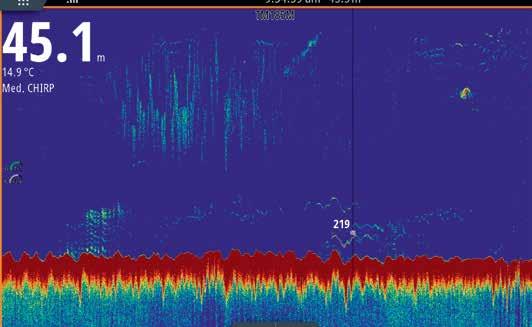






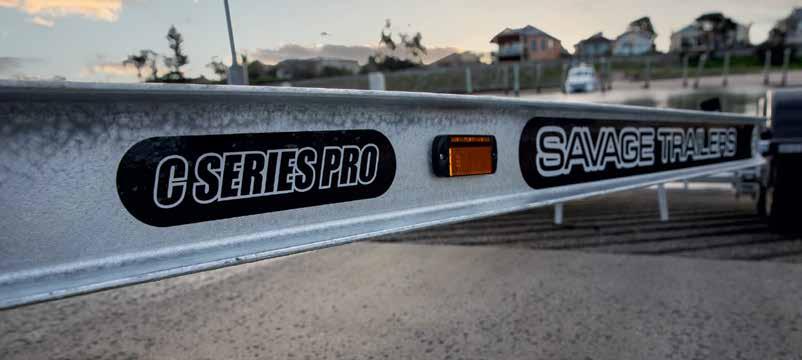




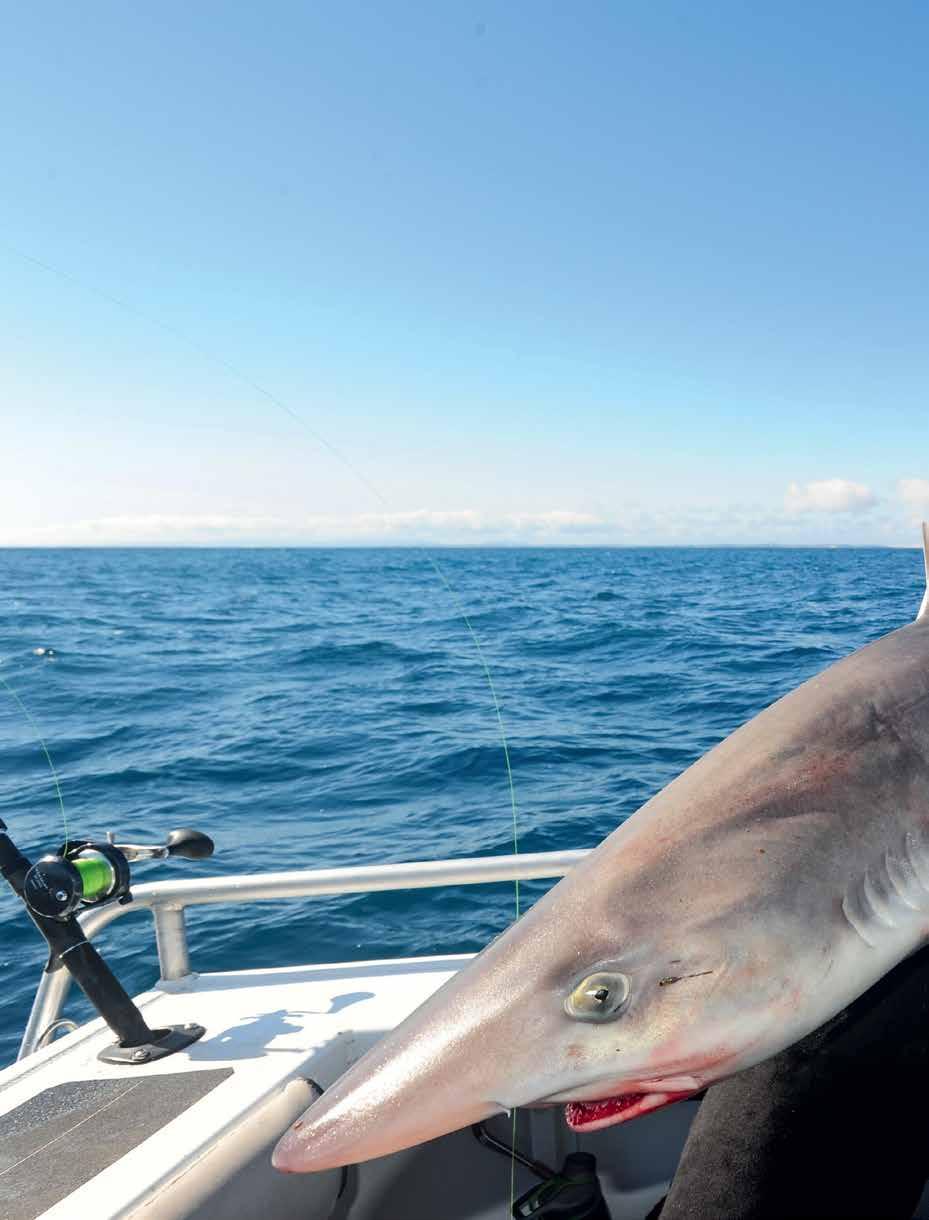
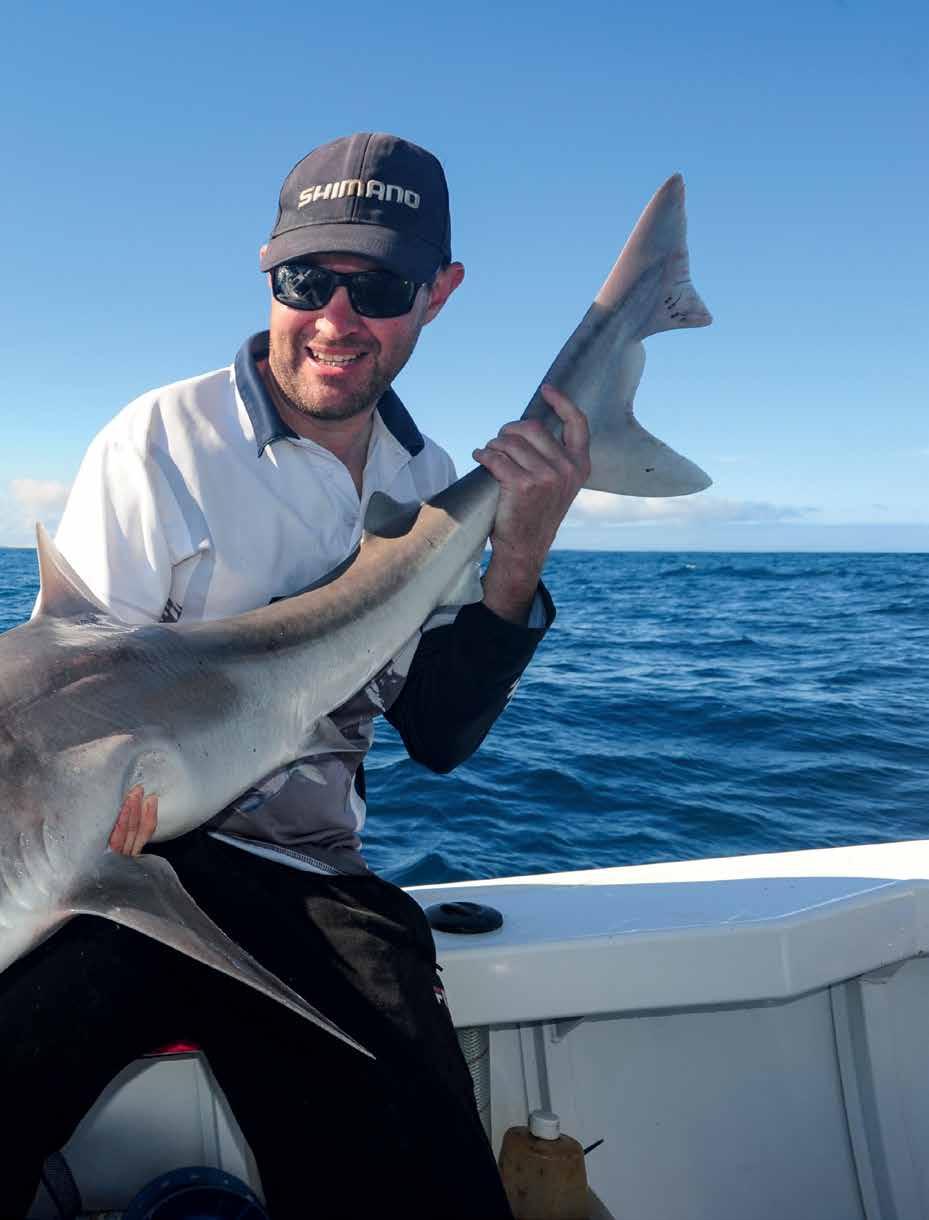

swallowtail, but we find the school sharks often shadow these schools of fish.
The beauty of drift fishing is we can target these other species at the same time and keep on the move until we locate some school sharks. We’ll usually fish paternoster rigs with a pair of 6/0 octopus pattern hooks on two droppers (one hook per dropper) to catch a feed of table fish such as red snapper. Quite often the activity of smaller fish being hooked will draw in some schoolies, and we’ll either mark them on the sounder, or a small fish such as a red snapper will be bitten in half. Sometimes we’ll manage to lip-hook a school shark on these smaller rigs.
Once we know some school sharks have arrived, we’ll drop some bigger baits such as squid heads, fish fillets or cut baits (such as slimy mackerel or tommy ruff) down into the column using the same rigs as detailed when fishing on anchor, except we’ll use a slightly heavier sinker – usually 8oz or 10oz to ensure the bait sits at the desired depth. We’ll lift these bigger baits slightly off the bottom – like we do when on anchor – to ensure they aren’t ratted by the smaller reef fish. The bite from a school shark can be surprisingly subtle and sometimes looks like it could just be smaller fish playing with the bait, but once the hook is set it’s a different story.
In the outfit department, a quality 6000-sized thread line reel and a rod in the 10-12kg range, or around PE3, is ideal for schoolies. Likewise, a similar-sized overhead rod and reel will do the job nicely. Because of the deeper water we’re fishing, braided mainline is a must. I use 40lb braid with a 60lb mono shock leader, and this does the job nicely.
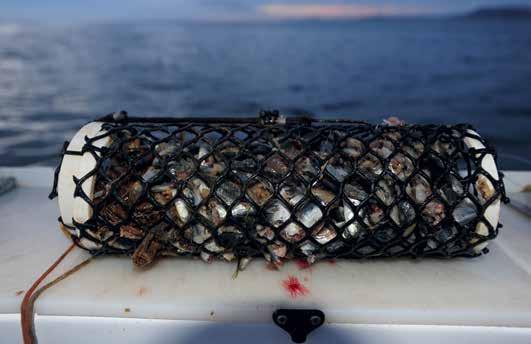
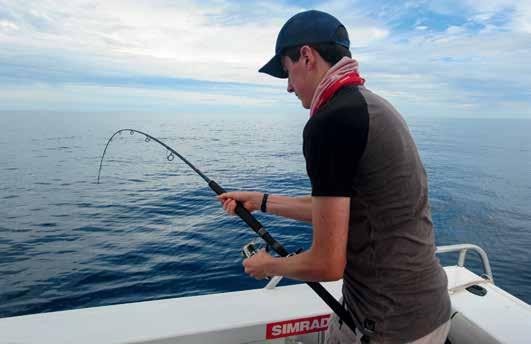
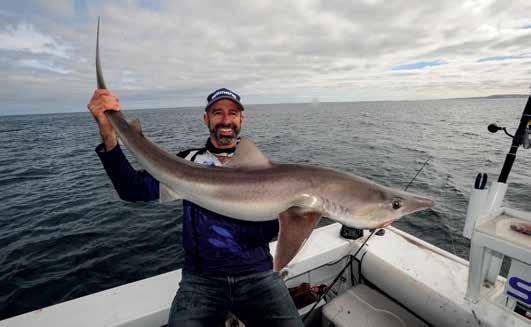
School sharks can be interesting once you have them boat-side, with plenty of sharks lost in the final stages of the fight. They are masters of rolling up the trace line and winning their freedom. For this reason I always try to lead a school shark into a big landing net, and you can give them a moment to thrash and roll before lifting them aboard. If you are going to keep a shark for the table, try gaffing and lifting into the boat in one motion to lessen the chance of the shark rolling off the gaff – you would be surprised how often this can happen. If you are keeping a shark for the table, bleed and ‘trunk’ the shark as soon as possible, and after a thorough flush with salt water place into ice as soon as you can to chill and set the flesh. School sharks are a cool species to target in our southern waters, and their numbers are on the rise. If you haven’t looked for schoolies in your local area it might be worth investigating.

ST.Croix Rods have been handcrafting the Best Rods on Earth® for the past 75 years manufacturing rods in North America. We strive to offer the most advanced Rods using the finest materials and give the angler a true angling experience! Our passion is your passion and that’s why we offer the Gold Standard in Rod Warranties with our rods coming with an ‘Unconditional’ 15 or 5 Year Warranty! (See our website at www.jurofishing.com for





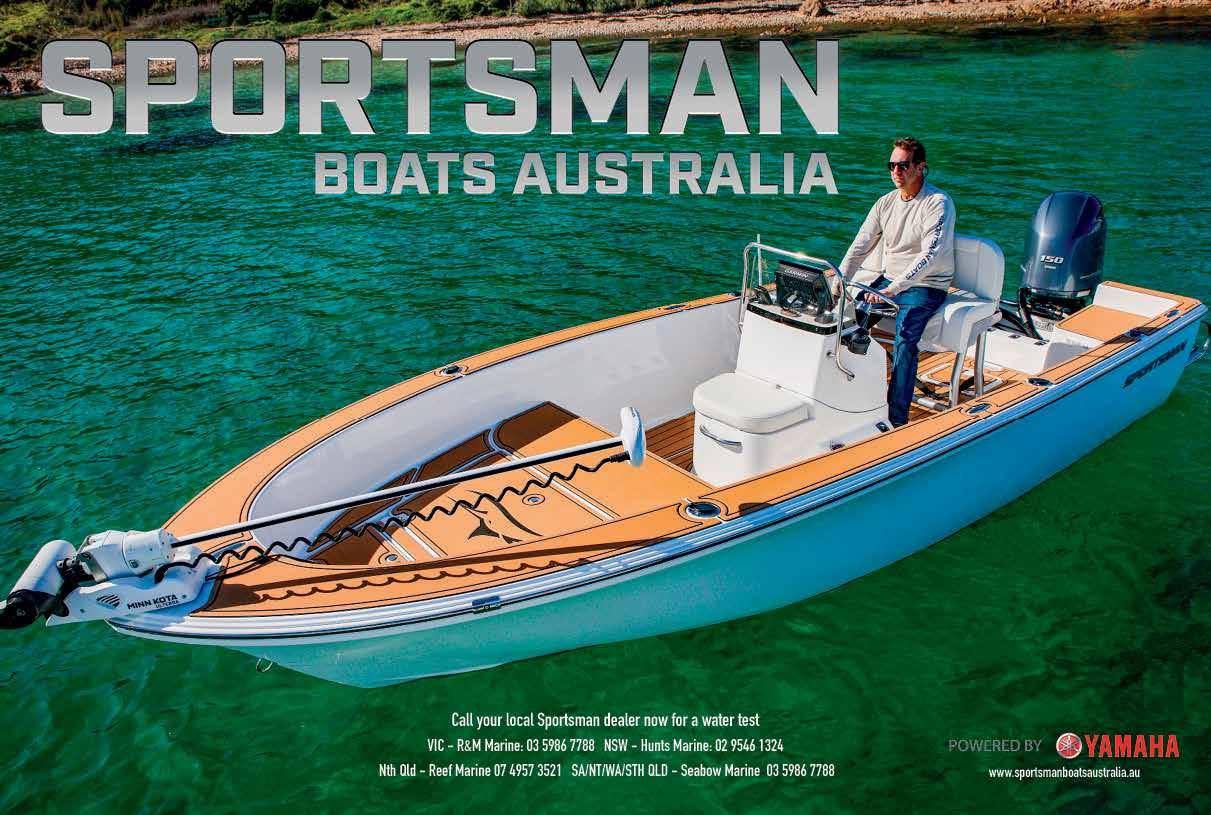
Work out how these ambush predators hunt prey and you’ll soon realise they’re not ghosts, just a fish you need to better understand.
Words & Images: Jack Hammond
Mulloway are a prized target species in estuary systems along the east and south coast of Australia and can be commonly found in locations that many anglers drive past while searching for them. In this article I will be noting some key points I use to find mulloway in a river estuary system, and some of the little tricks to encourage them to eat a lure in tough conditions.
Finding where to start looking for mulloway in a river is a challenge but if you go back to basics it can be quite easy to find them in the right conditions. Mulloway are an ambush predator and will generally travel to find a food source but they will also hold up in places with structure as it provides easy cover to hide so they can hunt their prey. Generally you will find a bait source around structure, which will make the mulloway stay in the area for easy hunting opportunities.
The main structures to look for mulloway are rock walls / break walls, bridge pylons, jetties, deep holes on river bends and fallen timber structure. If you know an area with any of these types of structure and good tide flow, I guarantee there will be mulloway nearby. During the day I will target mulloway in the deeper parts of the river in anywhere from 4m to 10m. They can be easily spooked by boat traffic and even a transducer beam pointing on them, so fishing a little bit deeper allows the fish to feel a little bit less aware that they’re being hunted, which increases the chance of a bite.
During the night, mulloway will venture up into the shallows to look for food and occasionally feed off the surface in the right conditions, but to find these fish you must be stealthy as they are well aware of their surroundings. Having an electric motor on your boat is essential for mulloway fishing as they will swim away if they feel like they’re being hunted and will not eat, so take your time when motoring around for mulloway and make as little noise as possible.

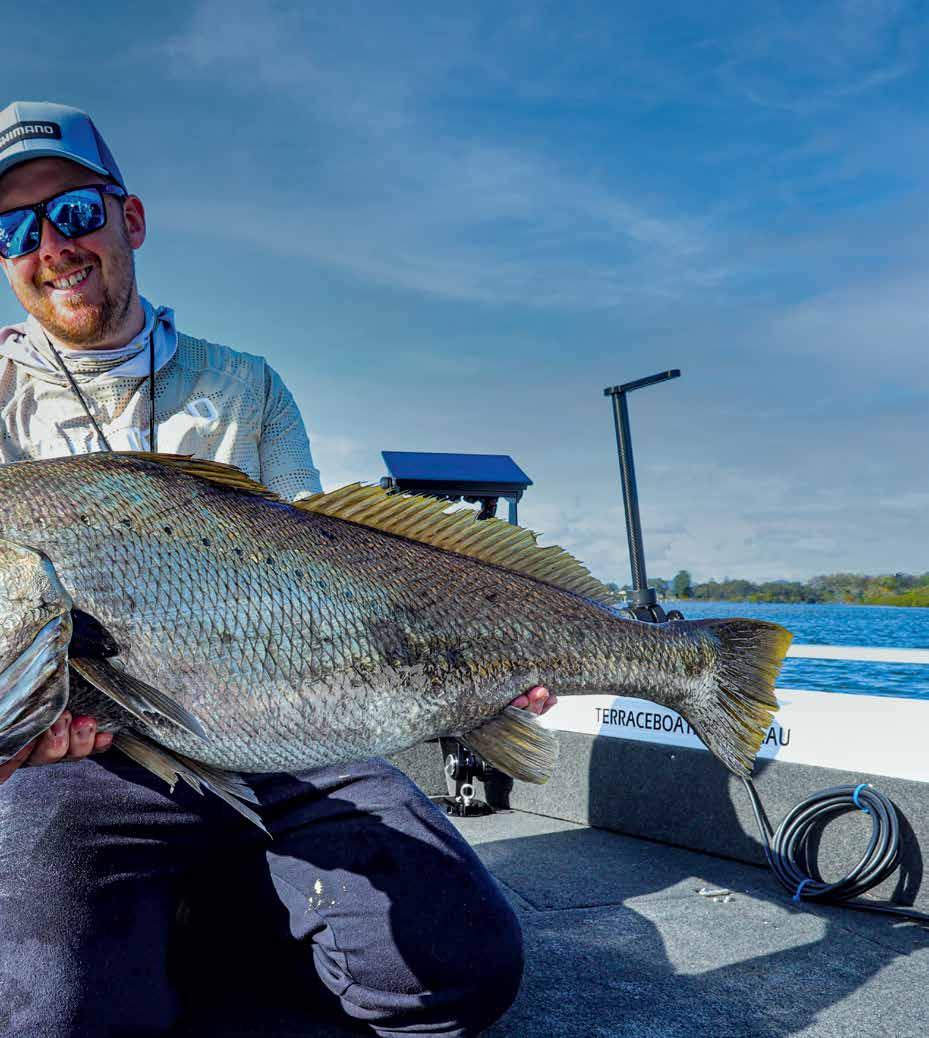










I have learnt mulloway in rivers can be switched on or off in their feeding modes, and the small things I have realised is they generally switch to feeding mode if there is other life in the area such as dolphins pushing bait around, or schools of prawns or other fast-moving baitfish getting pushed down a river by tailor or other smaller predators.
But the biggest factor mulloway respond well to is the lunar phase at different times, and I’ve found moon rise, moon set, moon above and moon below are key bite times. Barometric pressures are also critical, and I believe the saying, ‘Anything over 1010hpa is OK for mulloway, anything below is a nogo’. But if you have a pressure spike before a storm, or a change in weather is on its way, I see that as a golden opportunity to target mulloway any day of the week.
Tidal flow seems to fish better in a river system rather than the slack tide and I believe if you can put your lure in front of a mulloway they see it as an easy snack. They are likely to eat it if it is well-presented and your lure will blend in more naturally flowing






down with the tide, not spooking the fish as much as on the slack tide. On the slack tide I have seen fish on my live scope become more active but they are more focused on feeding from bait schools rather than individual baits and I have noticed they will spook easier if your lure lands in the wrong position from the way they are travelling, or if it sinks too fast. I have found the way to trigger the bite on a tide change is to downsize your jig-head and slow your retrieve to keep your lure in the zone for longer.









Depending on the time of year, mulloway will be hunting different types of prey. In winter they will be harassing mullet schools and in the warmer months they will be more focused on school prawns and herring. In the winter months the larger mulloway will tend to venture up the rivers to get ready to spawn in spring, and in summer you will find a lot more juvenile mulloway up the rivers and fewer bigger fish. So depending on the time of the year lure selection is a critical consideration when targeting mulloway.




In winter try to match a mullet profile and fish fairly heavy from 20-40lb, and in the summer downgrade your tackle to 10-20lb tackle as the fish are smaller and hunting smaller baits. You need to be prepared for both cases in the event you come across a school of trophy fish, so you always want to have your heavy gear in the boat to increase your chances of stopping the fish of a





The main styles of lure I like to throw for mulloway are soft plastics in a river system and hardbodies along a rock wall or headland, but my main go-to lures are paddletails to imitate a mullet, such as the 100mm to 175mm Squidgies fish and prawn-shaped plastics. With regard to colour, I opt for motor oil in dirty water and natural colours in clean water. Depending on the depth I let my lure sink as slowly as possible to give it the most natural look as possible as they can spook very easily if your lure is bombing down on top of them, not allowing them enough time to look at it before deciding if it is lunch or not. It is all trial and error setting up your lure to swim to perfection to maximise your chances of catching a mulloway.







The Lox Yoshi range has been revered for by

experienced anglers for many years now and Lox has tonne + 46 tonne (46 tonne butt section) Japanese blank design and technology to provide exceptional

just released the new and improved Series IV. Lox rod blanks are crafted from high-modulus 30 Toray carbon and feature advanced IV core loop technology.

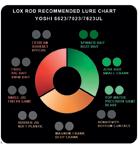























Lox incorporates the latest advancements in rod performance.









The Series IV core loop boosts stability and reduces distortion across the blank’s loading zone, resulting in greater power and faster recovery compared to carbon is not only stronger and lighter but also more responsive than standard 30 tonne carbon. This rod is









traditional blanks. The 30tonne+ 46 tonne Toray




highly recommended for experienced anglers






























Knowing how to use your sounder and tweak your settings can be the make or break to spotting a fish or mistaking a fish as a rock (or not even seeing it), so having your transducer reading the bottom clearly and your settings dialled-in are vital. When fishing a river I will mainly have my sounder on Side-Scan full time and I will generally look along every rock wall, pylon and hole in my tracks as mulloway won’t always hold up in the same area, and you will sometimes find them in areas you would least expect. Most modern sounders should show the basic shape of a mulloway if you have it set up correctly, so don’t be afraid to be adventurous with your settings and teach yourself how to set it up –or look at booking in a sounder course with an expert as it definitely pays off.

Quality rods and reels are a must when targeting mulloway as they will expose any weakness in your set-up. I’m constantly changing my leaders after every trip and retying my lure after catching a fish as the next one could be the fish of a lifetime. For winter mulloway I will use a 4000-size spin reel with
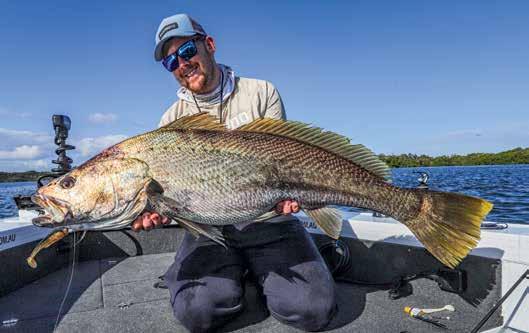
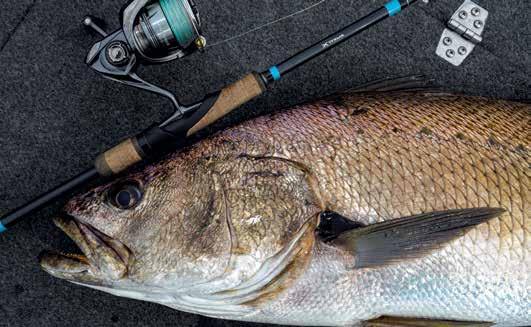
20lb braid and 20-40lb leader matched to a 4-8kg 7ft rod. This set-up is enough for me to be able to turn the head of a hard-fighting big mulloway while remaining a relatively finesse outfit and offering an enjoyable fight where I can appreciate those special moments and how special these fish are. When targeting the smaller summer fish I will fish a lot lighter using 2500-sized reels with 14lb braid, with 16-20lb leaders matched to a 6-12lb 7ft spin rod as I will fish a lot slower than in winter and with more finesse to trigger the bites as the fish are more focused to smaller baits.
Mulloway stocks are recovering but it is still important to look after these fish, even in shallow water, so make sure you obey your state’s rules and regulations. If you’re releasing a fish try to keep it out of the water for as little time as possible and take your time to make sure the fish swims off with a strong kick.











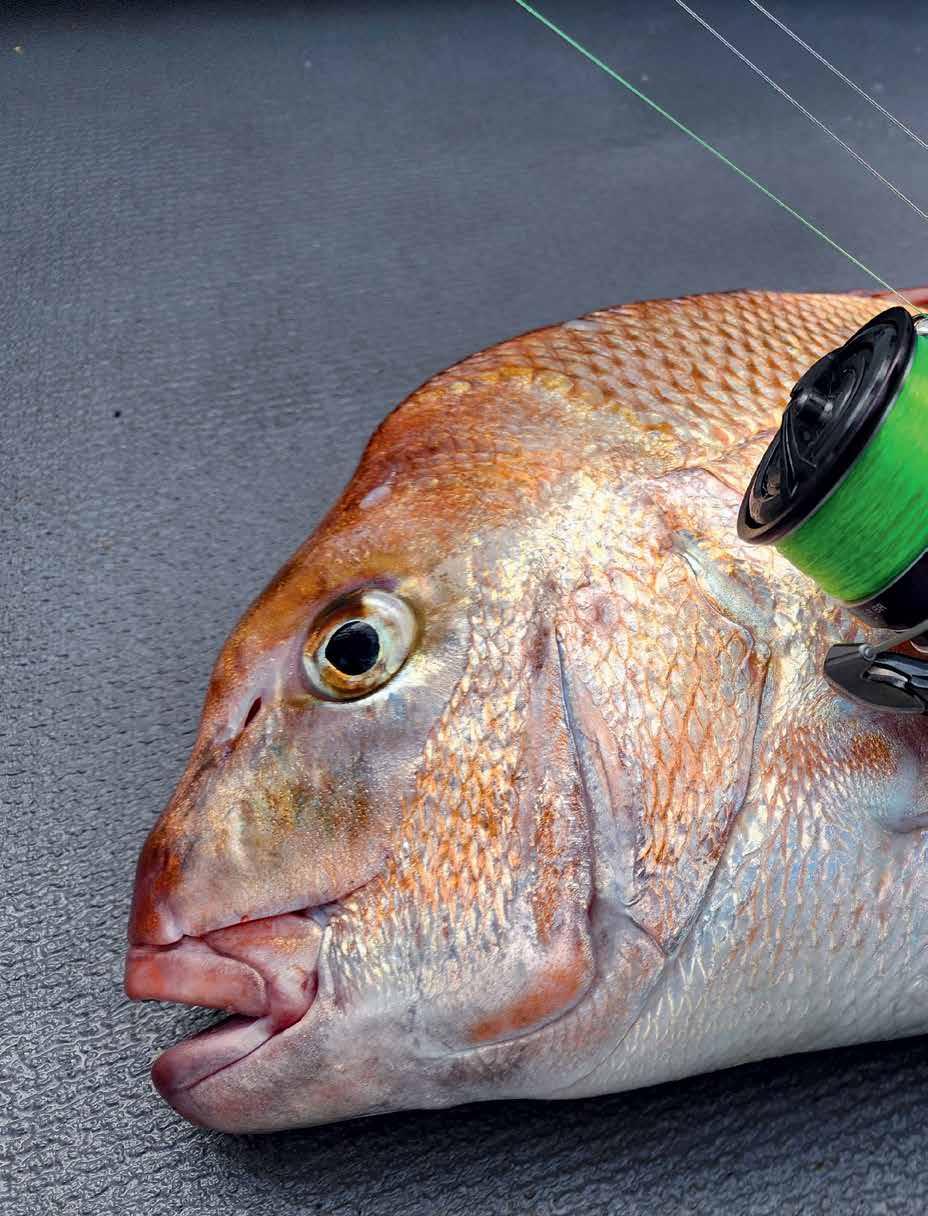
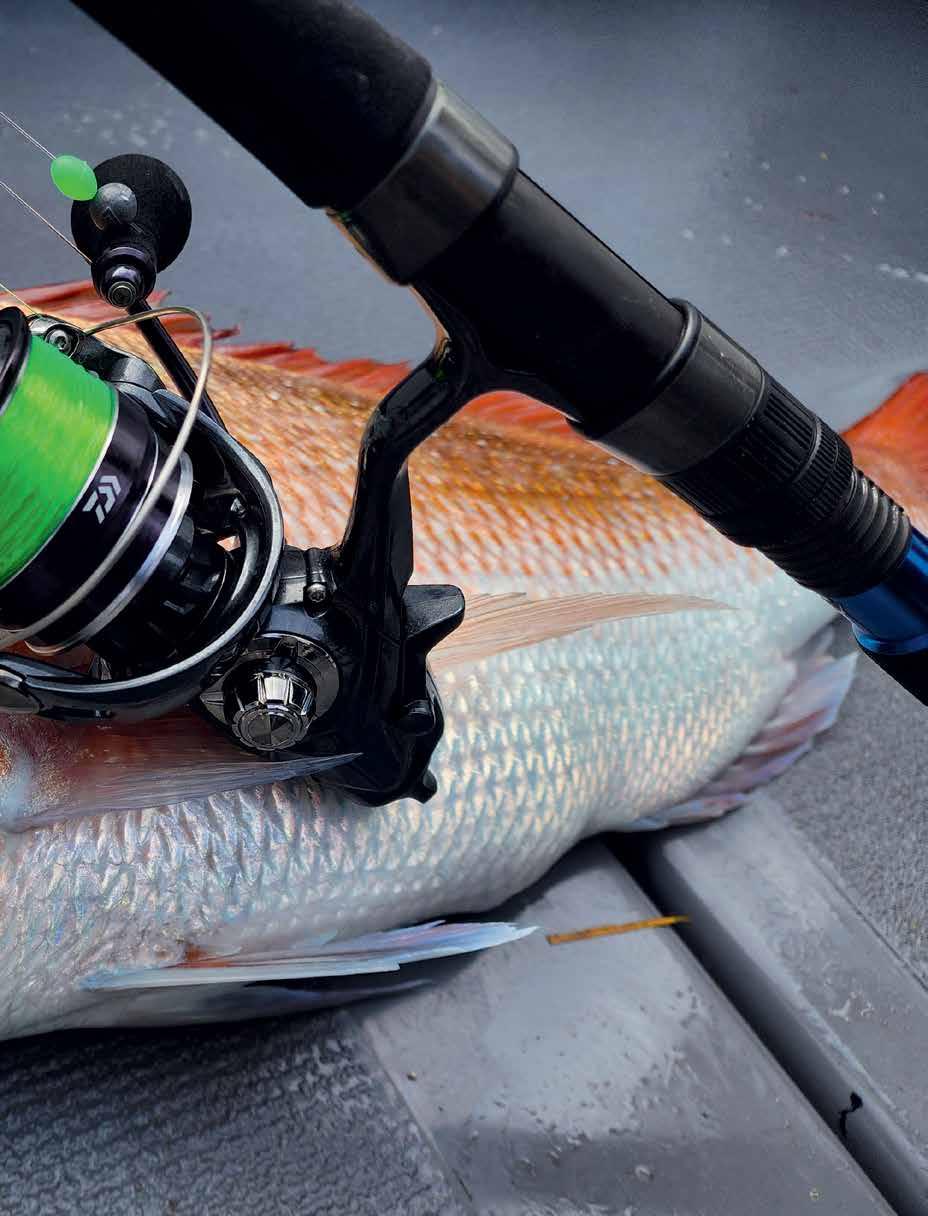

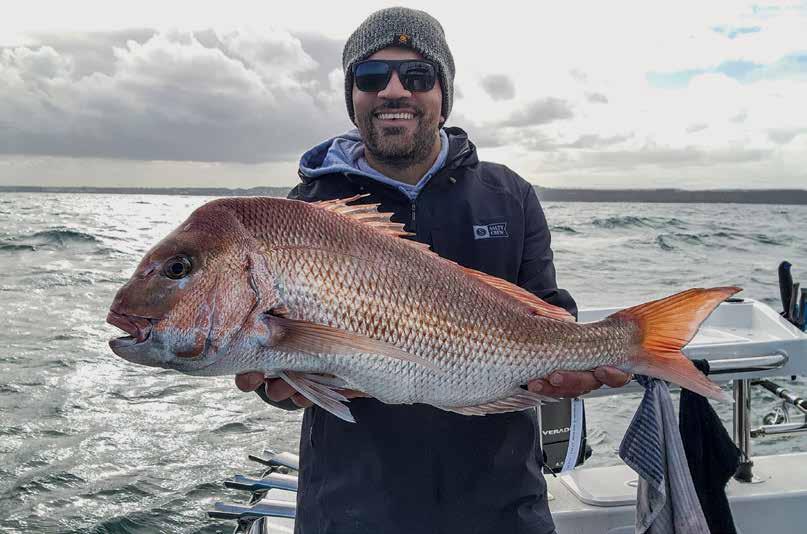
Since Daiwa released its Free Swimmer BR range, snapper anglers have been eagerly waiting for smaller sizes to complement the already impressive 8000 and 10000 models. The good news is that Daiwa has listened, delivering the much-anticipated 3000 and 5000 sizes that are perfect for southern snapper fisheries such as Port Phillip Bay. These new sizes are a game changer, offering a balance of lightweight design, solid drag performance and a user-friendly free spool function that makes them feel like a natural extension of your hand.
I’ve been using the Free Swimmer 10000 and 8000 for some time now, and while these larger sizes excel at targeting gummy sharks and kingfish, they were often overkill for smaller species such as snapper. That’s where the 3000 and 5000 sizes really shine. Both feel like they’ve been made for Port Phillip Bay’s snapper fishery. I paired the 5000 with the new Daiwa Saltist PE3/4, a rod that’s a near-perfect match for snapper fishing with its long EVA butt, perfect guide train and medium-fast action. This combo has accounted for multiple fish this season, including a solid 5.5kg snapper, and has performed exceptionally well.
The 3000, on the other hand, was matched with my tried-and-true Daiwa Tierra 4-8kg rod, a lighter option that’s been in my fleet for a few years. I never felt undergunned on the 3000 despite its smaller size. For the majority of snapper fishing in shallow waters, this reel is more than capable of handling everything from smaller models to solid 5-6kg fish.
One of the standout features of the Daiwa Free Swimmer series is the Bite ’N’ Run (BR) system. For those unfamiliar, this allows anglers to engage the reel in free spool with the flick of a lever, which is perfect for live baiting or letting a fish pick up a dead bait without feeling resistance. It’s a critical feature for snapper fishing in Port Phillip Bay, where bites are often timid. The Free Swimmer’s BR system is incredibly smooth and efficient.
The free spool mechanism itself is seamless, with the drag knob easy to adjust and the clip that brings the reel into free spool working flawlessly. I’ve never had any issues with missed hooksets or drag misfires during testing. The tension adjustment on both models provides just the right level of sensitivity – tight enough to handle larger baits, but forgiving enough that even the most finicky snapper can pick up the bait without
feeling any weight. It’s a refined system that really enhances the overall fishing experience.
Another area where the 3000 and 5000 Free Swimmers excel is their balance and feel in the hand. The rounded EVA power knob provides excellent grip and comfort, particularly when you’re cranking on fish after fish with wet slimy hands from handling bait and berley.
While this EVA knob may seem insignificant, it really makes a big difference out on the water and it shouldn’t have taken this long for anyone to fit this style of reel with a knob like this. Both reels are beautifully balanced and well-matched to their respective rods, which makes them incredibly comfortable to fish with for extended periods.
The weight savings of these smaller reels over the 8000 and 10000 models make a real difference, particularly in terms of sensitivity. Smaller reels are naturally lighter, and this translates into a better sense of what’s going on at the other end of the line. The line lay on both reels is superb, providing smooth, consistent winding.
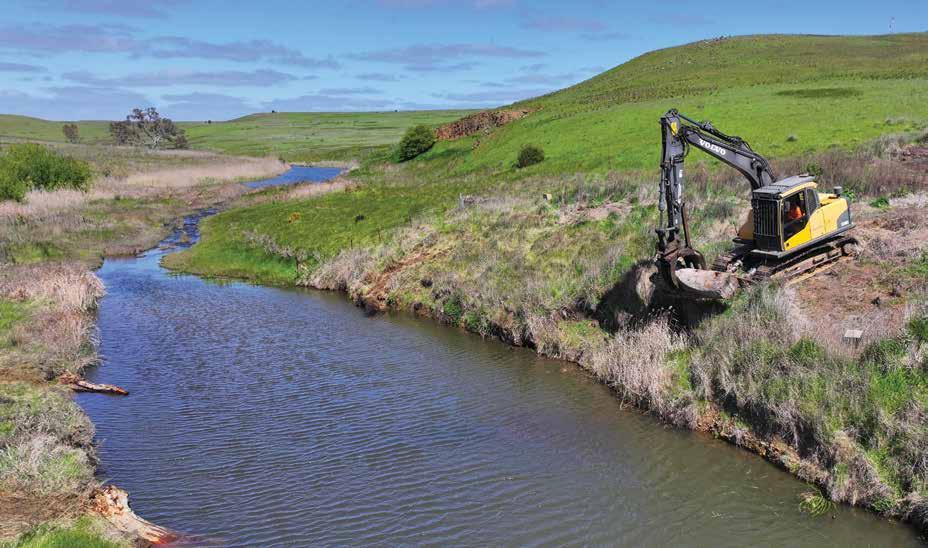
Spawning habitat for blackfish in Tullaroop and Birch’s creeks just got a whole lot better thanks to your recreational fishing licence fees and the North Central Catchment Management Authority.
Large tree trunks and root balls were modified and installed into the creeks, between Newlyn and Tullaroop reservoirs, in time for the spring and summer breeding season.
Blackfish lay their eggs on hard, clean surfaces, which make these natural structures ideal. Custom hidey-holes were cut into the trees, which were secured to prevent dislodging during high flows.

Go Fishing Victoria
More people fishing, more often


Both the 3000 and 5000 models feature Daiwa’s ATD drag system, and pack a massive 10kg of drag that you’ll probably never need even half of when baitfishing for snapper. However, if you were targeting kingfish with braid it will be welcome on the 5000. The drag is exceptionally smooth and consistent. Whether you’re dealing with a powerful snapper or smaller fish, the drag performs beautifully across multiple captures. I’ve had the chance to put both sizes through their paces on a variety of snapper, and I’ve been thoroughly impressed with their ability to absorb long, powerful runs and short bursts on the initial hit while maintaining steady, controlled drag pressure.
The build quality of these reels is what we’ve come to expect from Daiwa – rugged, reliable and well-engineered. There’s zero flex in the body, and the reels feel solid throughout the fight. This is particularly important when you’re targeting snapper, as you need a reel that can stand up to the occasional big fish without buckling under pressure.
I spooled the 5000 with Shogun IGFA Green 16lb mono, a reliable line but nothing amazing as it is relatively thick. I managed to get almost 300m on it. I spooled the 3000 with 16lb Sunline Super Natural and got a perfect 150m. This is a thinner, more finesse line, and this is more than enough. Even though it’s not as robust as the 5000 or 8000, I’ve never felt the 3000 lacks the line capacity to handle the fish I’ve been targeting. If you were fishing in deeper offshore waters, I could see the 3000 struggling with longer runs, but for inshore snapper fishing, it’s ideal.The 5000, with its slightly larger spool, offers a bit more peace of mind should you hook into a really big fish. While I still don’t think you’d risk being spooled on the 3000, the 5000 will give you a bit more capacity for those larger, offshore snapper or when fishing deeper. Both models excel in terms of line management, with no tangling or performance issues, even with me keeping slack lines out in the racks and winding it up at speed.
In conclusion, Daiwa’s Free Swimmer BR 3000 and 5000 reels have quickly become two of my favourite set-ups for snapper fishing. They offer a perfect balance of size, performance and ease of use. The free spool system is smooth and easy to use, the drag system is flawless, and the overall build quality is as solid as you can get. The best part is the price – at $239 they offer excellent bang for buck.
www.daiwafishing.com.au
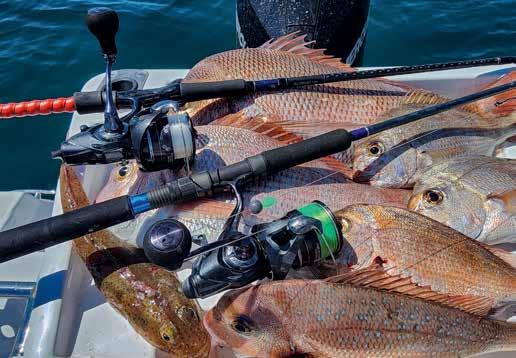





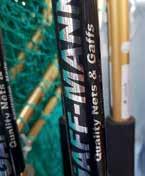


The Ahi Series is a barrel bluefin specialist that incorporates a 10Deg face angle and enlarged front section that reduces in size toward the rear half of the head. These features produce an exceptional outrigger or long corner lure, with excellent all round performance over a range of speeds from 5 - 9 knots. Six sizes make up the Ahi series from the huge XOS down to the Ahi #5, all with exceptional fish raising characteristics.




Words: Kosta Linardos Images: Kosta Linardos & Craig Pringle


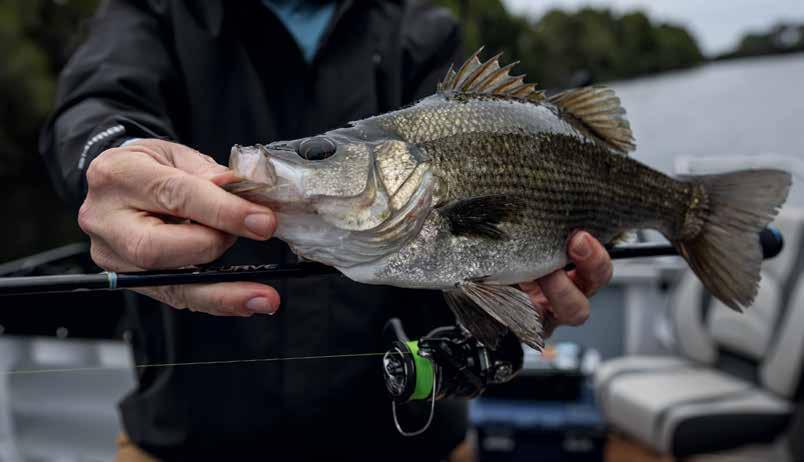
Shimano has long been a household name in the world of fishing reels, and with the release of the Vanford FA series, it has once again set the benchmark for performance and innovation, especially for finesse anglers. This new series has already made waves in the Australian market, with the Vanford 2000 and 2500 sizes becoming firm favourites in the fleets of light tackle enthusiasts targeting species such as bream, bass and estuary perch.
When the Vanford was first released in 2020 it quickly established itself as the successor to the popular Stradic Ci4+, but with an upgraded design and advanced features. One of the most talked-about things was the name itself. What does ‘Vanford’ even mean? To be honest, it’s just a name, but it signified a shift in Shimano’s thinking. Rather than continuing with the Stradic name, which had both metal and Ci4+ versions, Shimano opted for something fresh. The idea was simple: create a reel that pushed the boundaries of lightweight finesse fishing while maintaining the reliability and performance Shimano reels are known for. The Vanford was born, and it quickly gained a following, offering a reel that anglers could trust across a variety of species and fishing styles. We tested the original Vanford 4000 over the past four seasons, primarily for snapper fishing, and been thoroughly impressed with its ability to handle tough conditions without any failure. I then went and bought the 1000 and the 2500 and have loved using them.
The new Vanford FA series brings Shimano’s Ci4+ material to the forefront once again. This high-density carbon material is the key to the reel’s light weight and impressive strength, making it the ideal choice for those who need a reel that doesn’t sacrifice power for sensitivity.
I recently got the chance to test the new Vanford FA on bream and estuary perch in Bemm River, where I used both the 2000 and 2500 sizes. The 2000 size quickly became my go-to for the estuary fishing I was doing, and it didn’t disappoint. Whether I was casting light plastics into the snags or drifting over deeper channels, the Vanford 2000 was smooth, comfortable and incredibly responsive.
One of the most notable upgrades in the Vanford FA series is the new Duracross drag system, which Shimano has set at a modest 3kg on the 2000 model. This may seem conservative compared with the 9kg drag on the 2500, but I really appreciated the more controlled drag range on the 2000 size, particularly when targeting smaller species such as bream and perch. Having that level of control over the drag meant I could finesse my way through the fight, especially when dealing with tricky snags or aggressive fish. Shimano’s decision to fine-tune the drag performance on the 2000 size makes it a great choice for anglers who prefer a bit more control.
On my first few outings, I caught a couple of small bream, but the real test came when I hooked into a 44cm estuary perch. This fish ran straight into the thick structure, and I was thankful for the smooth and consistent Duracross drag that offered measured resistance throughout the fight, even as the perch tried to pull me back into the snags. It’s a high-performance drag system that performs well across the entire fight, and I managed to bring the perch to the boat without any issues (the video will be available on our Hooked Up YouTube channel in January).
When you’re fishing in the estuary or targeting light tackle species, smoothness and sensitivity are essential – and the Vanford FA doesn’t disappoint. Shimano has fine-tuned the reel to ensure buttery-smooth operation, making it ideal for long casting sessions or fine-tuning your presentation. The 2000 size, in particular, is a joy to fish with. The reel feels almost weightless in your hand, which is a huge advantage when you’re casting repeatedly for hours at a time.
For the test the reel was paired with the new T Curve 6ft 8in 1-3kg rod (which I was also testing), and the combination of the two was exceptional. The rod offers a medium action that’s forgiving, yet still has plenty of backbone for fighting fish. Its taper is just right – not too fast and not too slow – giving the perfect balance of casting accuracy and



Gosen has been innovating fishing lines for 70 years since its founding in 1951. Now, Gosen is returning to its roots and launching a new ROOTS line for all anglers


Gosen’s ROOTS fishing lines combine cutting-edge technologies to deliver unmatched performance. Through their unique “GT processing,” Gosen enhances PE material strength and abrasion resistance, while carefully selecting the optimal raw yarn for each line size to balance flexibility and durability. The advanced MPX and HDX manufacturing methods increase braid density and strength, minimizing breakage and friction-related issues. Additionally, ROOTS incorporates an innovative X resin and special silicone coating, ensuring superior colourfastness and reducing wear. This comprehensive approach results in a fishing line that offers exceptional strength, longevity, and resistance to fading, making it a top choice for serious anglers.
gladiatortackle.com.au
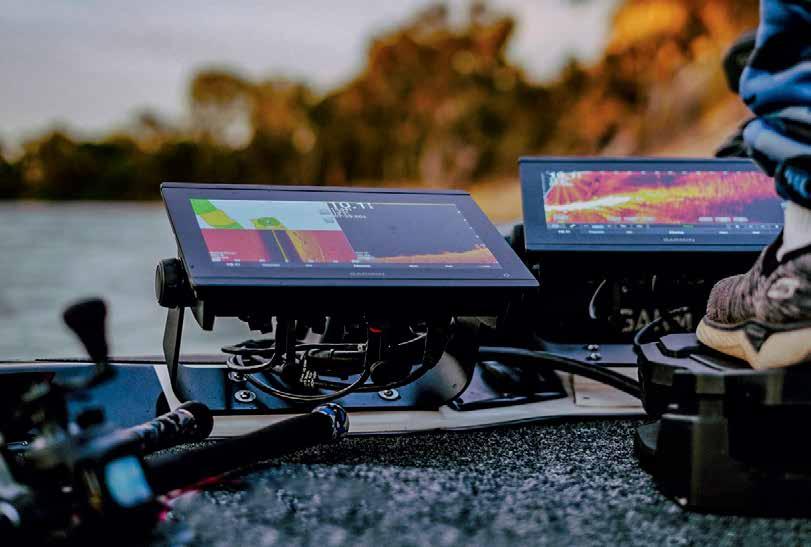

power for hook-setting. The Vanford FA, with its lightweight and smooth performance, paired perfectly with the T Curve rod, making it feel like an extension of my arm. Whether casting into the wind or precisely placing a light plastic in tight spots, the Vanford offered the sensitivity and control I needed.
I loved the fast gear ratio on both reels: 6:1 on the smaller 2000 and 5.8:1 on the 2500. When working plastics, surface lures and jerkbaits this fast gear ratio is greatly appreciated as you need to quickly pick up slack line to impart action on the lure and achieve a nice rhythmic cadence in your retrieve. Shimano’s Micro Module II gearing is exceptional and provides silent and smooth performance through the gears.
One of the standout features of the Vanford FA is the Anti-Twist Fin – a small yet incredibly effective addition that has completely changed how I think about line management. This little rubber fin sits below the line roller and prevents line slipping off the spool. After three days of hard fishing – casting into the wind, working light plastics, and trying to get the perfect presentation – I didn’t experience a single wind knot or tangle. This is an absolute game-changer for anglers who spend long days on the water casting repeatedly. The Anti-Twist Fin brings line management to a whole new level, allowing more time spent fishing rather than untangling knots.
It’s details like this that show Shimano’s commitment to pushing the envelope with its design and technology. The new Vanford FA offers exceptional line management and smoother operation than I’ve experienced in previous models of Vanford and Stradic Ci4+ reels. It’s a reel that not only delivers on the basics but also addresses some of the finer points that make a big difference during a long day on the water.
While the Vanford FA series is loaded with innovative features, it remains an accessible option for anglers. Shimano has managed to pack all this advanced technology into a reel that offers outstanding value for money with the 500, 2000 and 2500 priced at $399.
If you’re in the market for a reel that performs exceptionally well with light tackle, offers superb line management, and provides smooth drag performance (all with a 10-year warranty) the Vanford FA is tough to beat. Whether you’re chasing bream in the estuaries, flicking plastics for perch, or targeting any number of light tackle species, the Vanford is a reel you’ll find hard to put down.
www.shimanofish.com.au
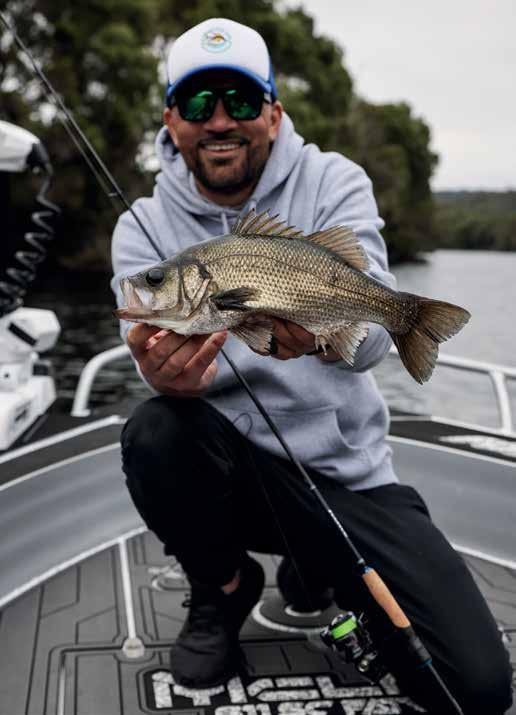







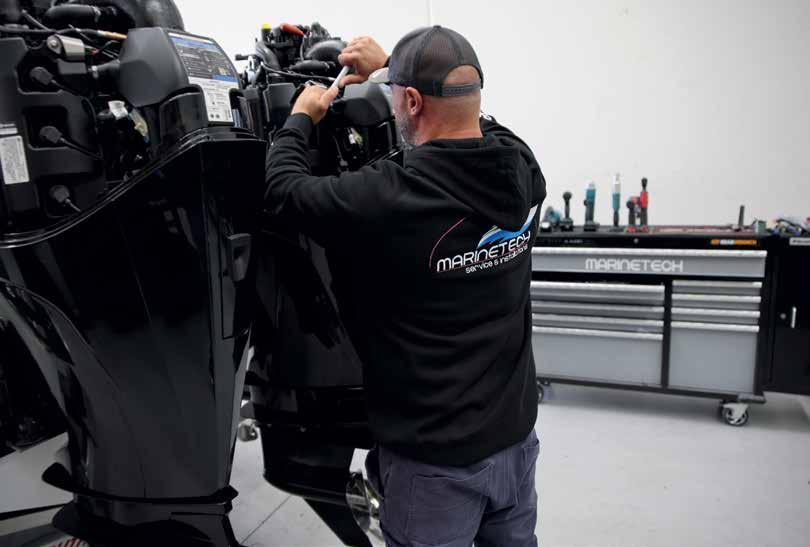

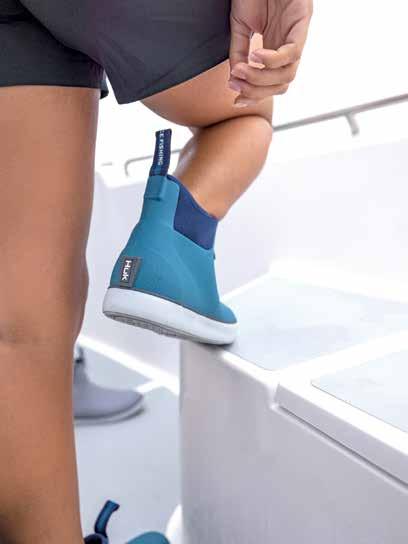


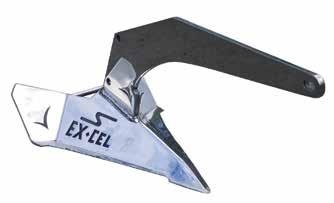


When it comes to iconic lure brands, few can match the legacy of Megabass. Known for producing high-quality, innovative products that are trusted by anglers worldwide, the brand’s range includes game-changers like the Siglett, Magdraft, Big-M, and Shading-X. These lures have all earned their reputations as proven fish catchers. For anglers who regularly test and review swimbaits, finding a product that combines durability, ease of use, and versatility is a rare feat—especially when targeting challenging species like Murray cod, mulloway, barramundi, and big flathead, which are known for their aggressive tendencies and rough treatment of tackle. Last year, I had the opportunity to review the Megabass SuWitch, which left a strong impression on me, so I was particularly excited to get my hands on the latest offering from Megabass: the Magdraft Hasu Raver. This swimbait is truly something unique, expertly crafted, and most importantly effective.
The Magdraft Hasu Raver is a 7-inch soft plastic swimbait, weighing in at 39gm with a slow float buoyancy. It’s designed to mimic the natural movement of prey with a subtle, lifelike action. But what really sets the Hasu Raver apart from many other swimbaits on the market is its innovative Maghold System. This feature allows the treble hooks to attach magnetically to the body of the lure, concealing the hook’s presence and making the swimbait appear much more natural to predators and preventing it from fouling on weed and structure. This subtle design element is a testament to Megabass’s commitment to both functionality and realism. The Hasu Raver is available in 15 amazing colour options, providing plenty of choices to suit different water conditions and target species. Retailing at under $40, it’s priced competitively for the quality on offer. While it looks delicate with its soft
plastic sgemnted body, the lure’s construction and design are built to withstand the harsh conditions found in estuaries, rivers, and freshwater lakes, making it a versatile option for species such as flathead, Murray cod, barramundi, and mulloway.
After having the chance to fish with the Hasu Raver for the past couple of months across several East Coast estuaries, I have gotten to know this unique lure well. The buoyancy of the Hasu Raver makes it ideal for fishing in areas with heavy structure and snag-prone zones. My primary focus was targeting flathead around shallow weed beds and submerged structures, and this lure proved itself exceptionally effective. The Hasu Raver is best fished with a slow and steady retrieve, where it performs a tight, controlled action. When reeled in at a steady pace, it provides an enticing, subtle snake
like movement that mimics the swimming action larger prey such as tailor, mullet and salmon. The lure’s real charm, however, lies in its versatility. When fished with a long draw of the rod, the Hasu Raver dives just below the surface. However, the lure also excels when twitched and retrieved with a more aggressive “walk-the-dog” style, producing a wide ‘S’ action that adds an extra layer of realism to the presentation. The action is incredibly responsive, and the lure can be easily manipulated whether you’re working it at a shallow depth or with a deeper, more deliberate motion. Fished with a low rod tip, it will dive a few inches beneath the surface, making it incredibly adaptable for varying fishing conditions.
One aspect of the Hasu Raver I was particularly keen to test was its adaptability when rigged with additional weight. I rigged the lure with both a 1/6 oz and 1/8 oz chin weight to explore how it would perform as a sinking swimbait. I’m pleased to report that the addition of weight did not negatively affect the lure’s action. In fact, the lure maintained its natural swimming motion with the weighted rig, making it just as effective for deeper presentations or when trying to target fish that are holding at a specific depth. This added flexibility is a real bonus for anglers who like to experiment with different retrieves and depths. One of the standout features of the Hasu Raver is its incredible ability to be fished in different scenarios without compromising its effectiveness. Whether you’re targeting fish near the surface, just below it, or deep down near the bottom, this swimbait’s action remains consistent.
I tested the Albino Pearl Shad colour, which worked exceptionally well in the clear water


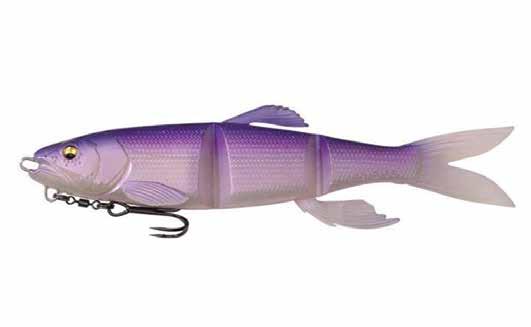
I was fishing. The colour has a natural translucency and subtle detailing. With 15 colour options to choose from, there’s a finish suited to almost every fishing situation, from clear to murky water, fresh and salt water or from bright sun to overcast skies.
The Megabass Magdraft Hasu Raver has certainly proven to be a worthy addition to the Megabass lineup. With its innovative design, excellent buoyancy, and unmatched versatility, it’s clear why this swimbait has already become a favourite among many anglers. If you’re looking for a high-quality, adaptable swimbait that’s built to last and proven to catch fish, at under $40, it’s a solid investment for anglers looking for a quality swimbait.
